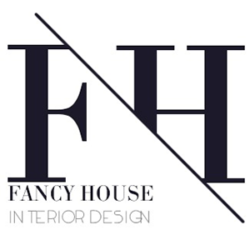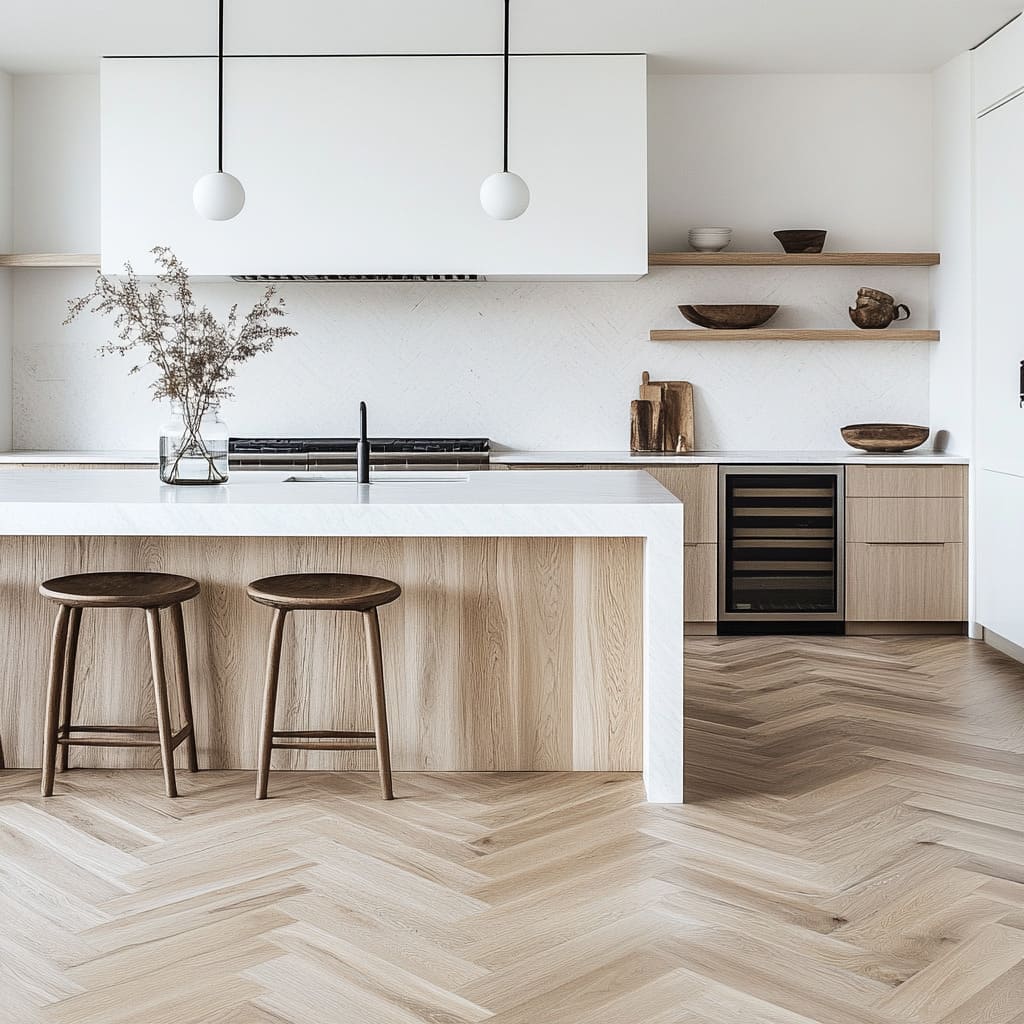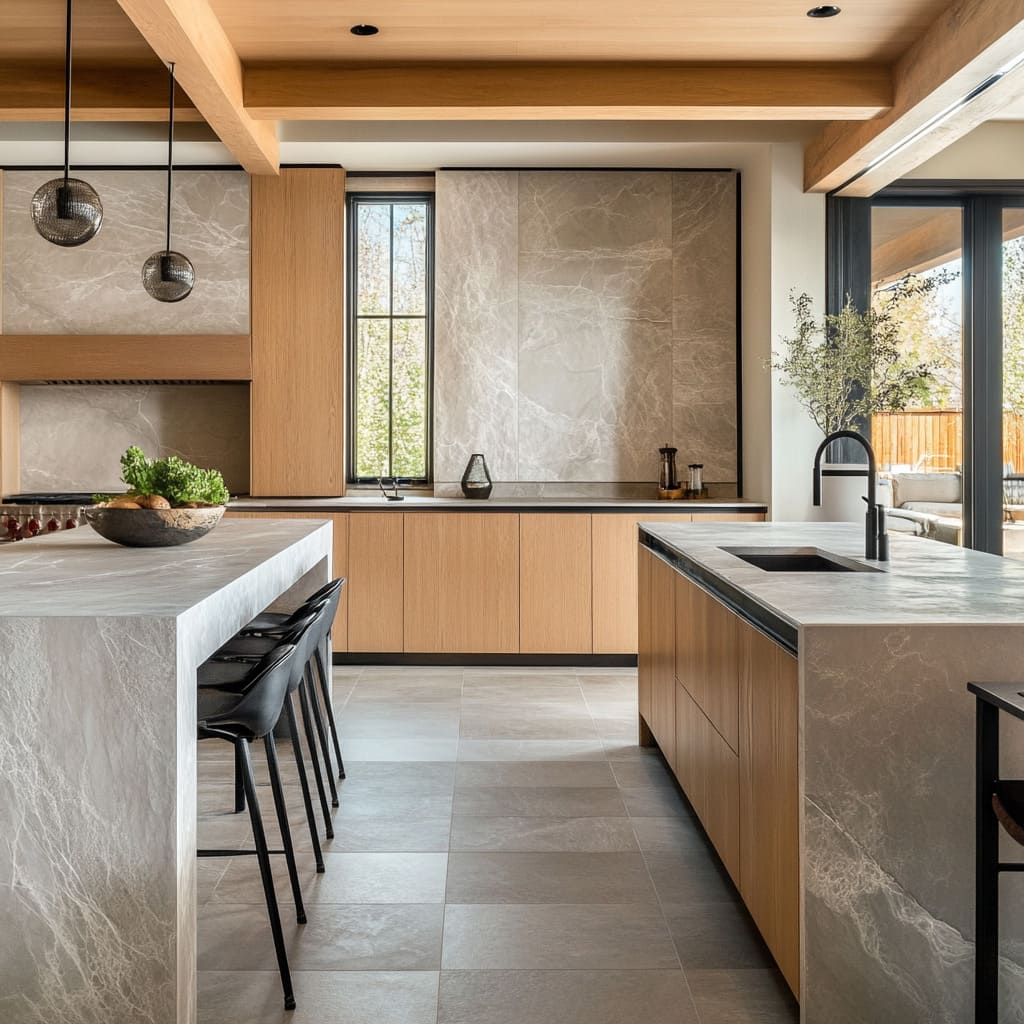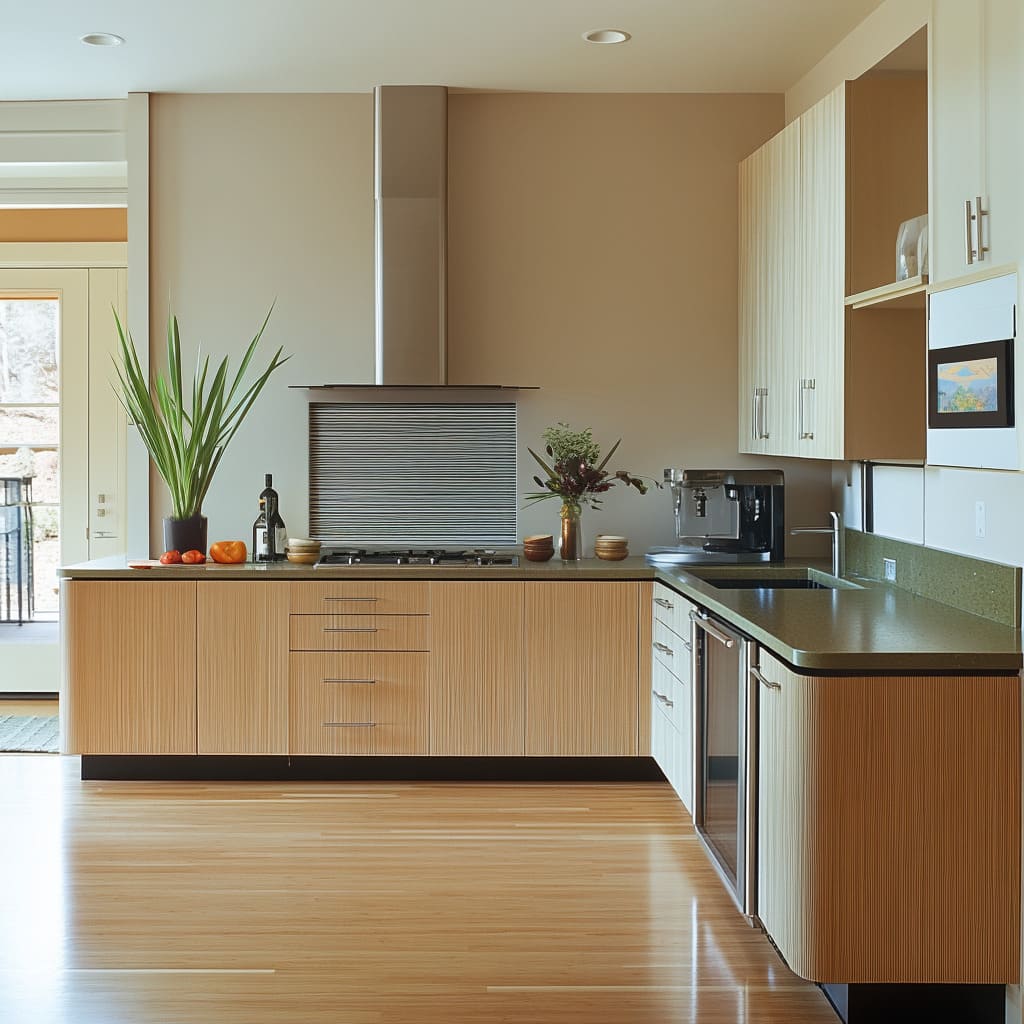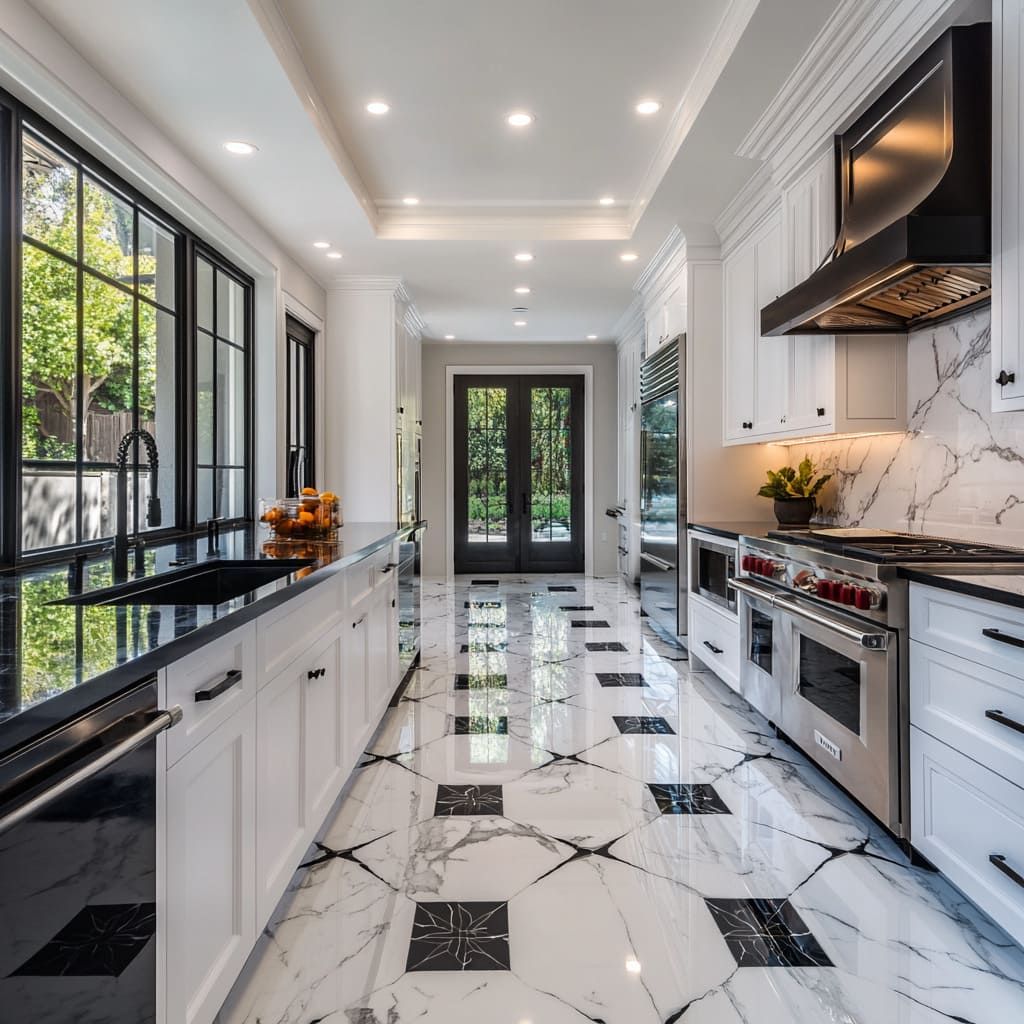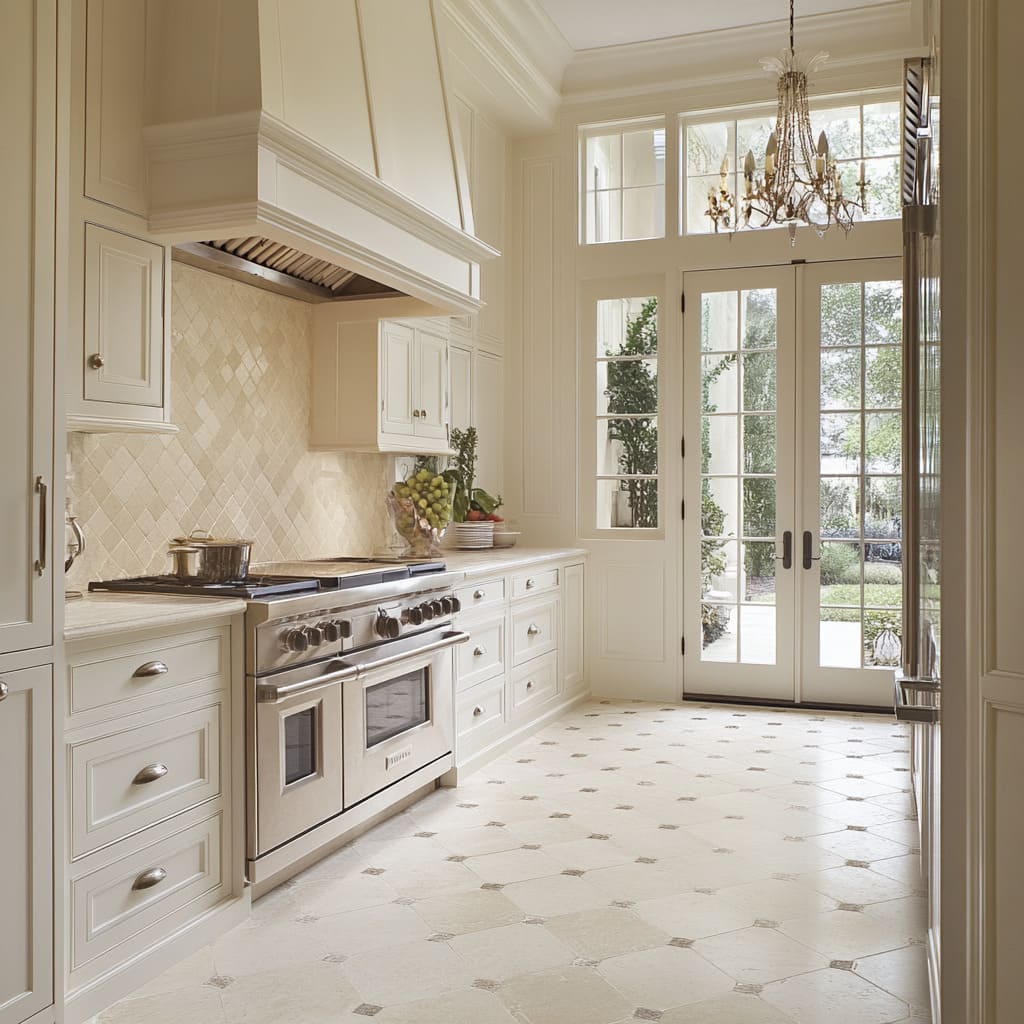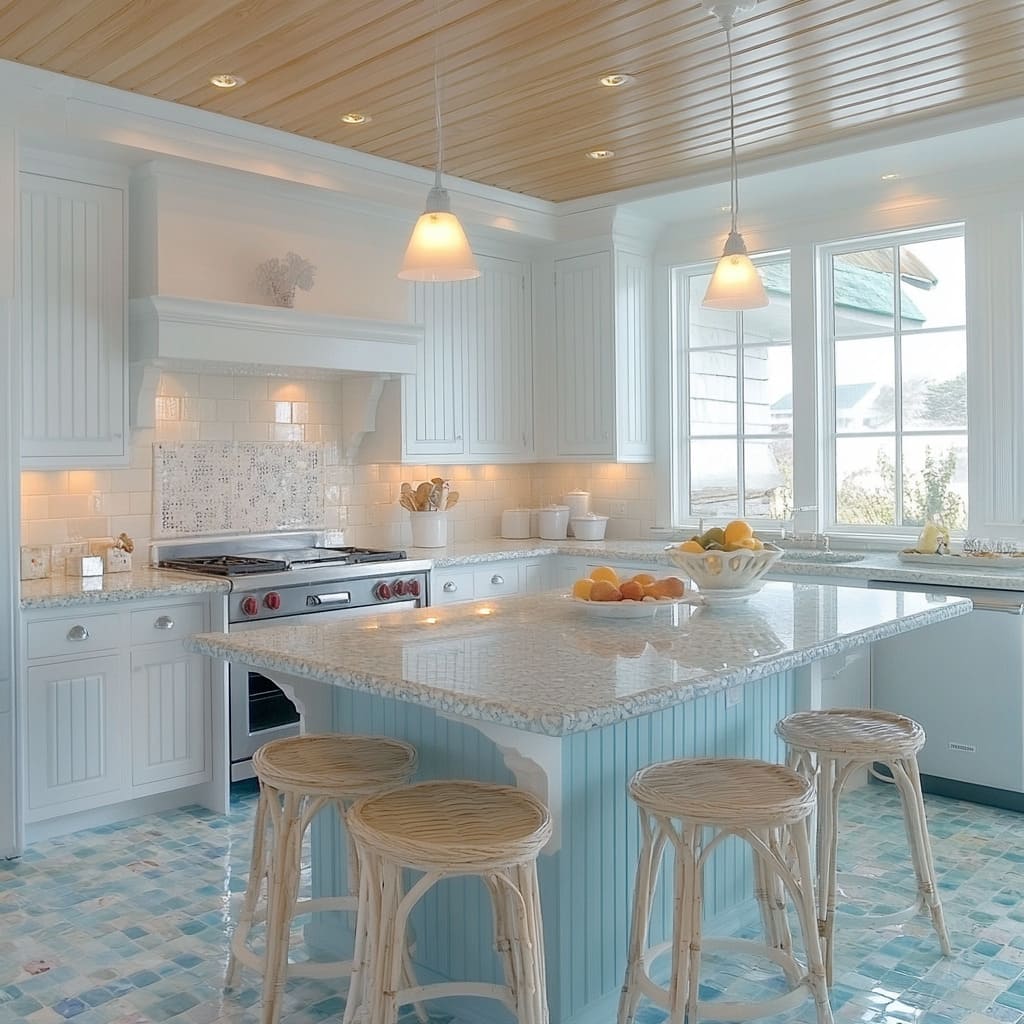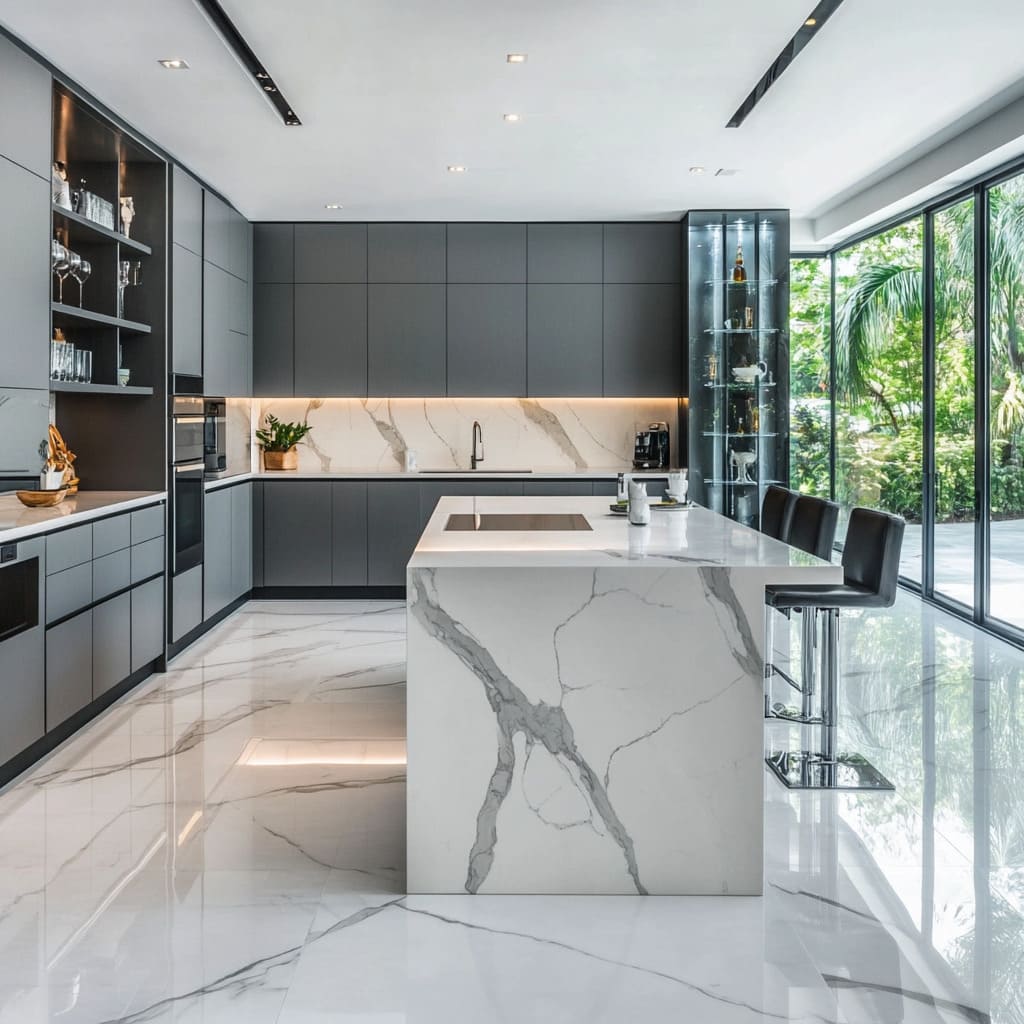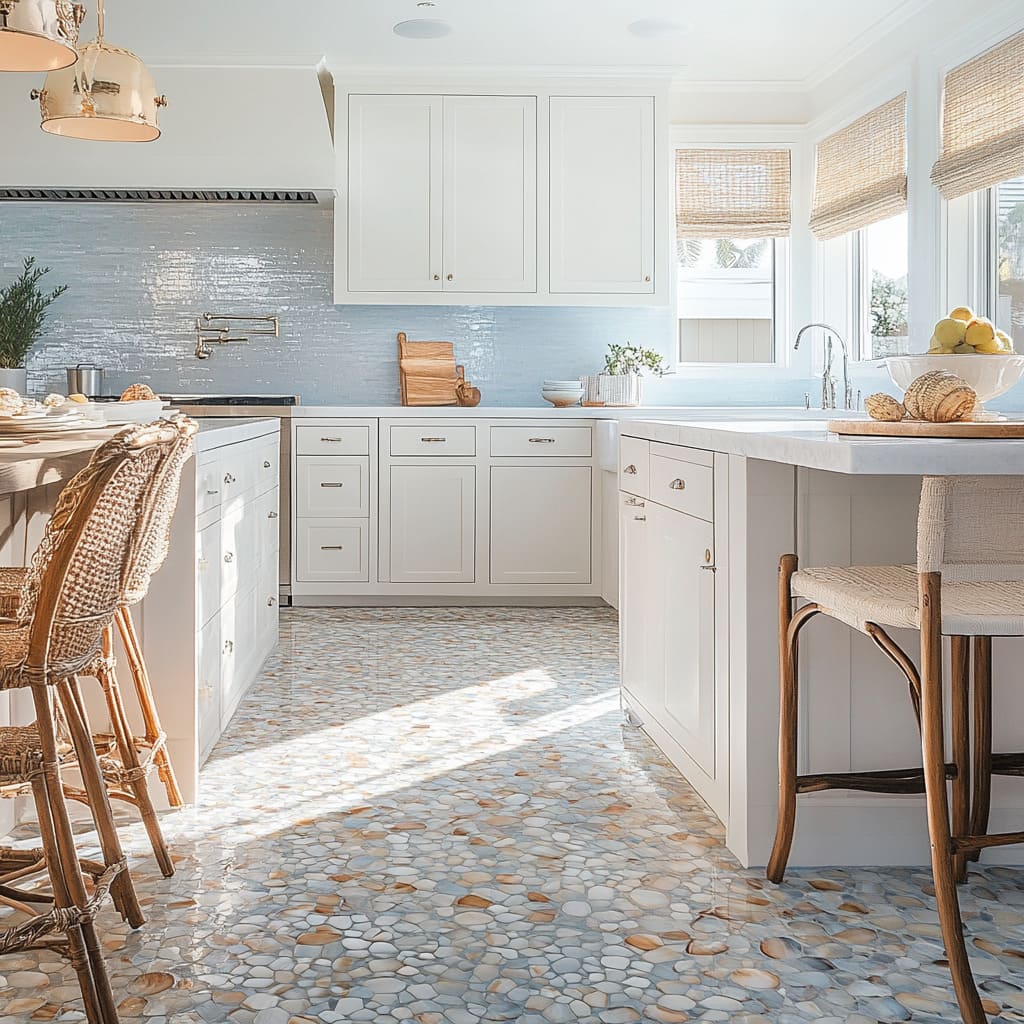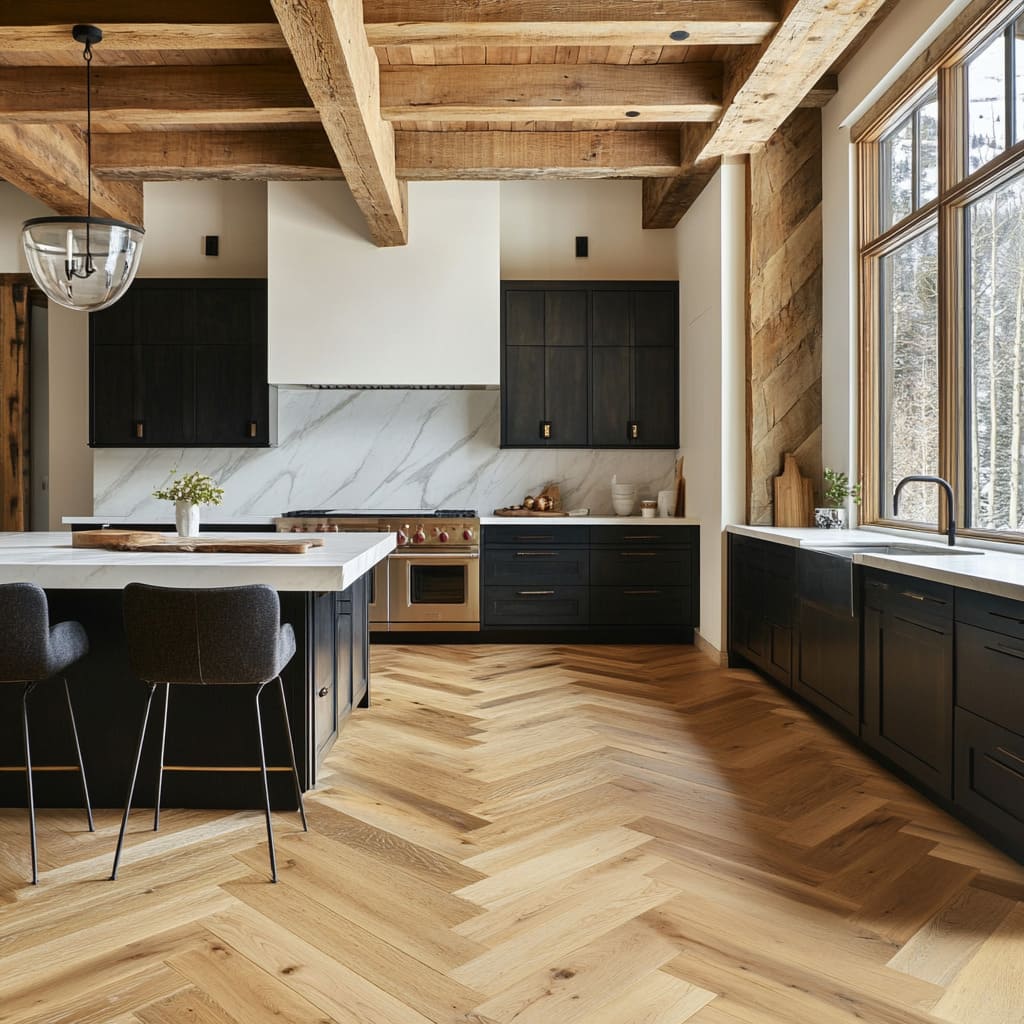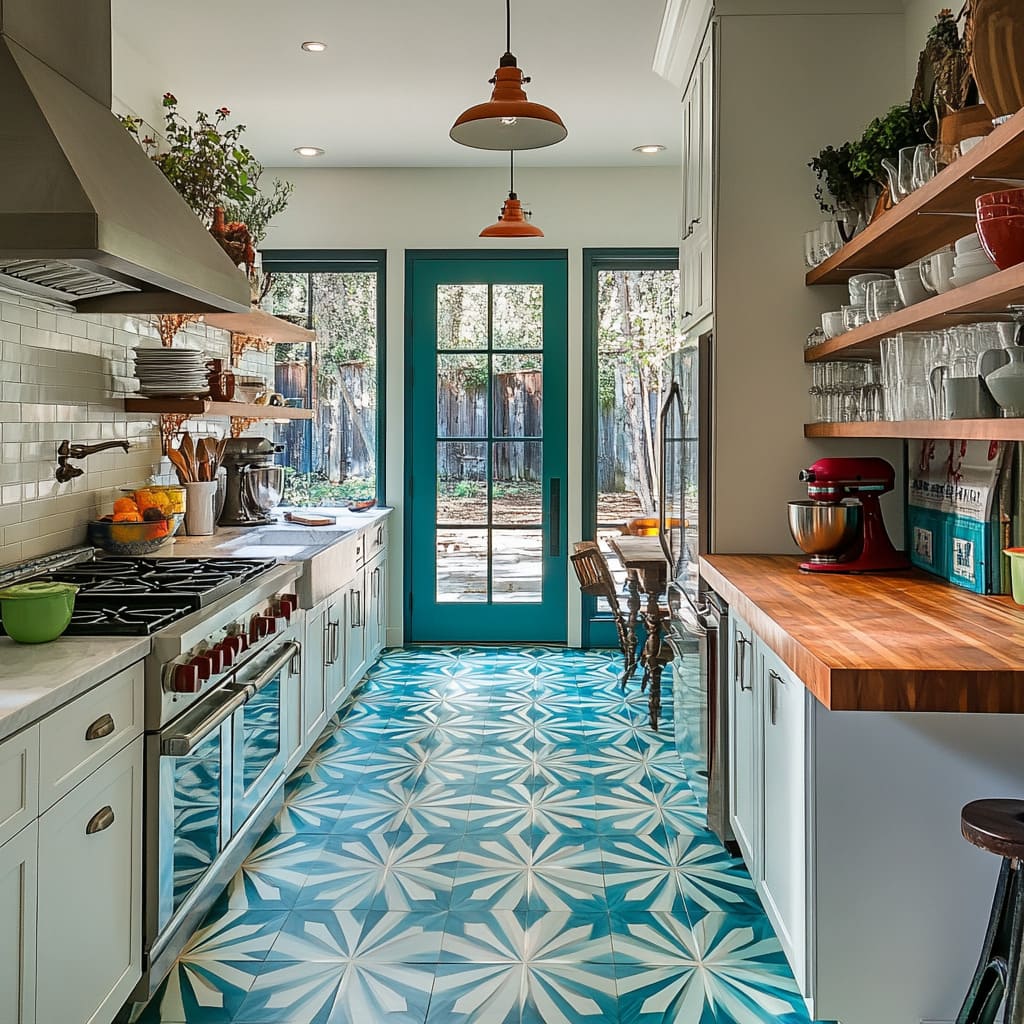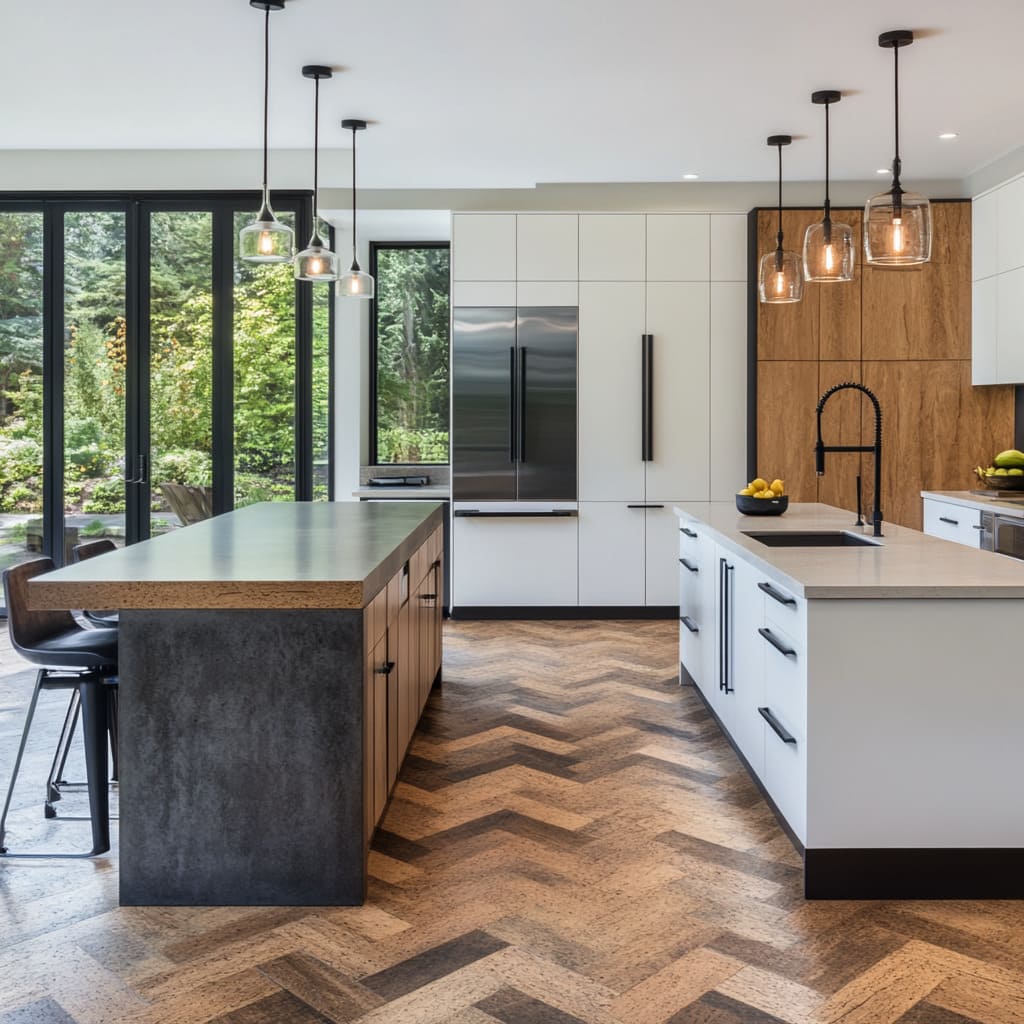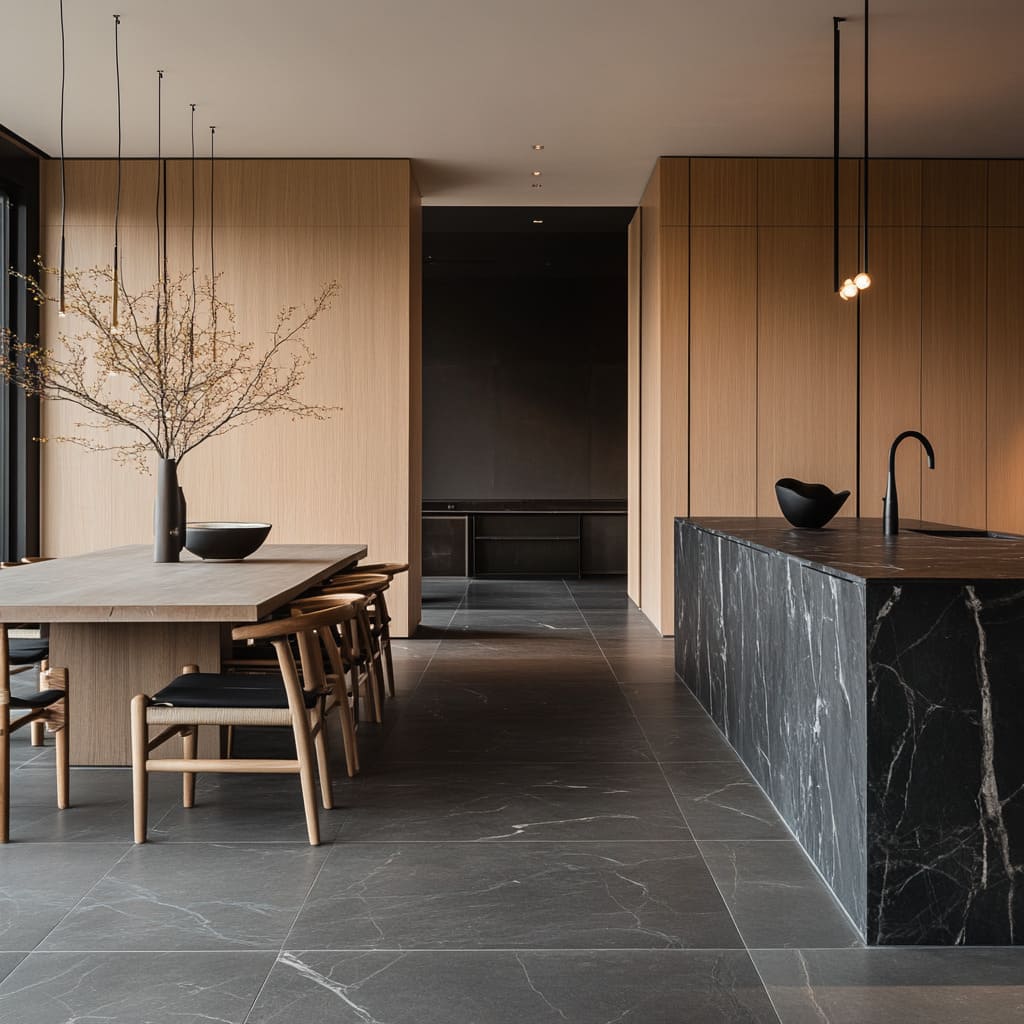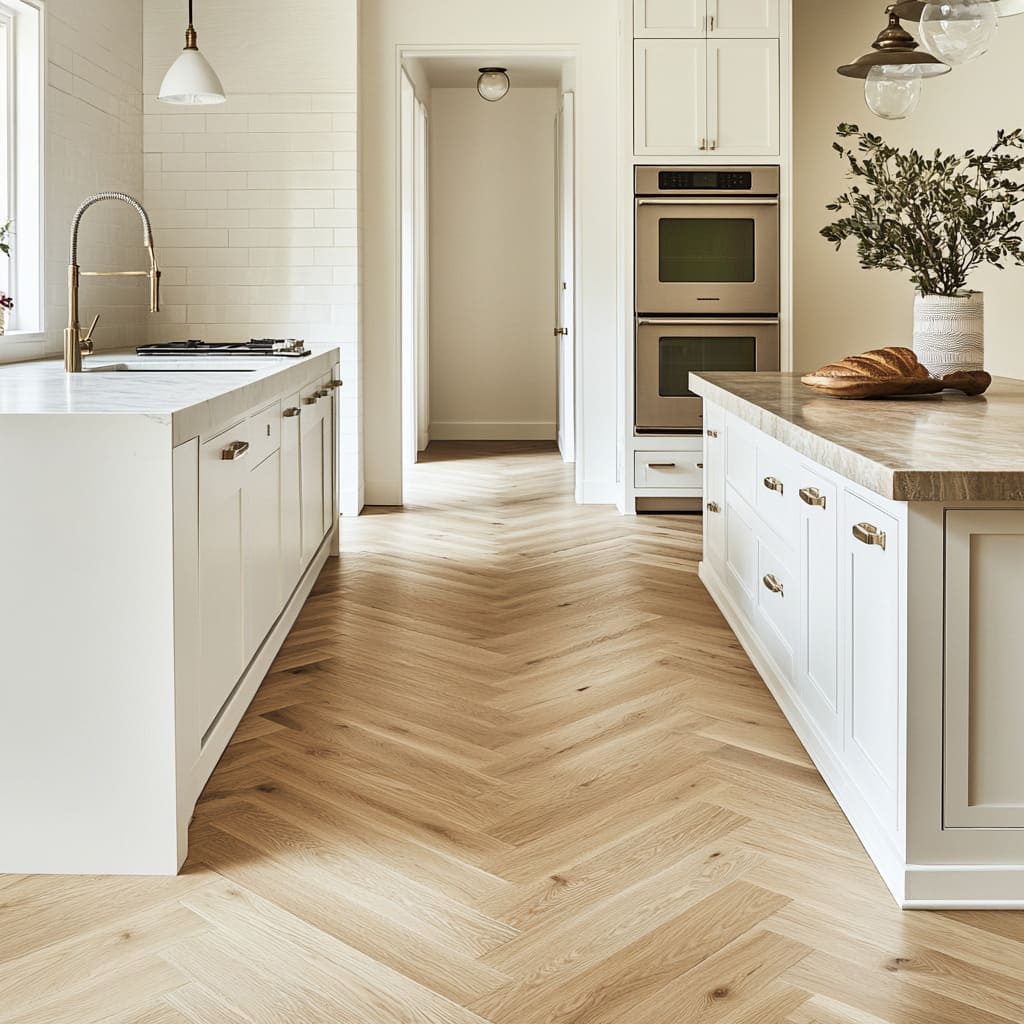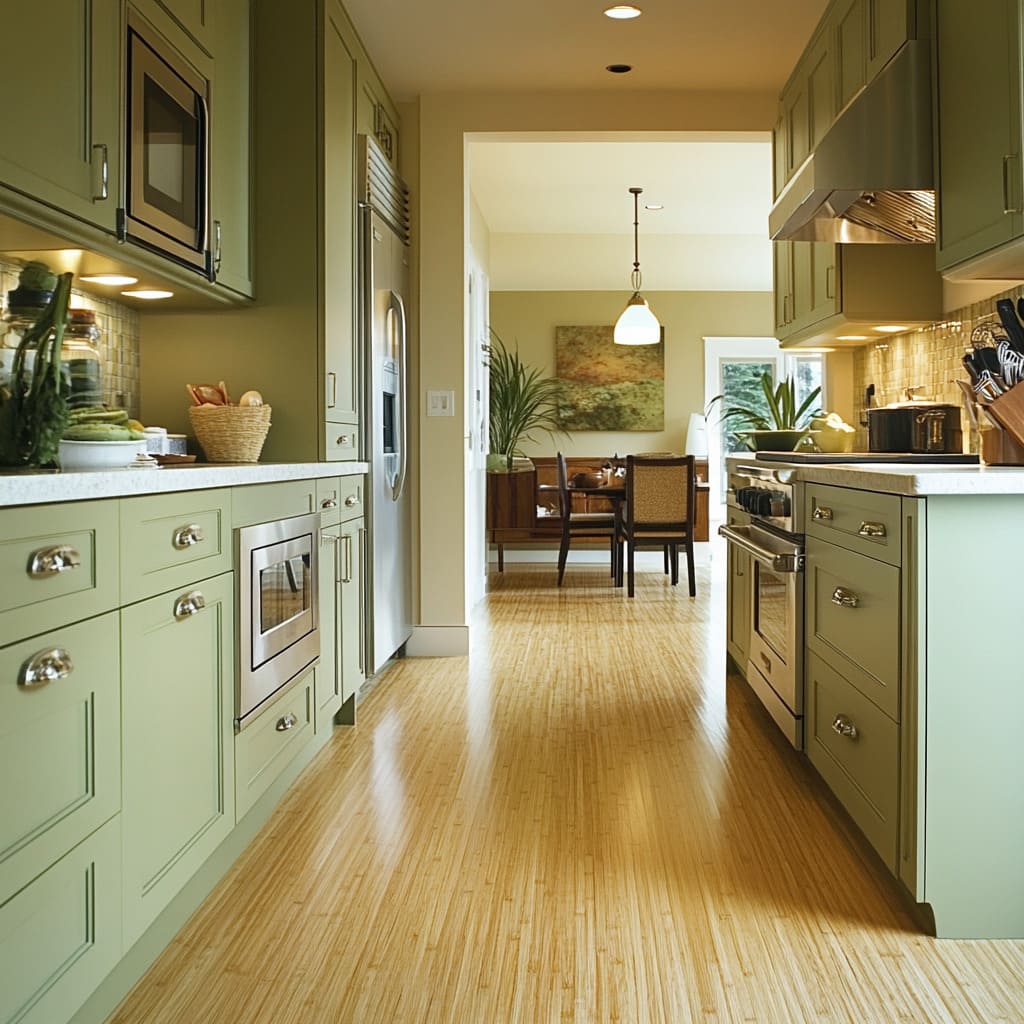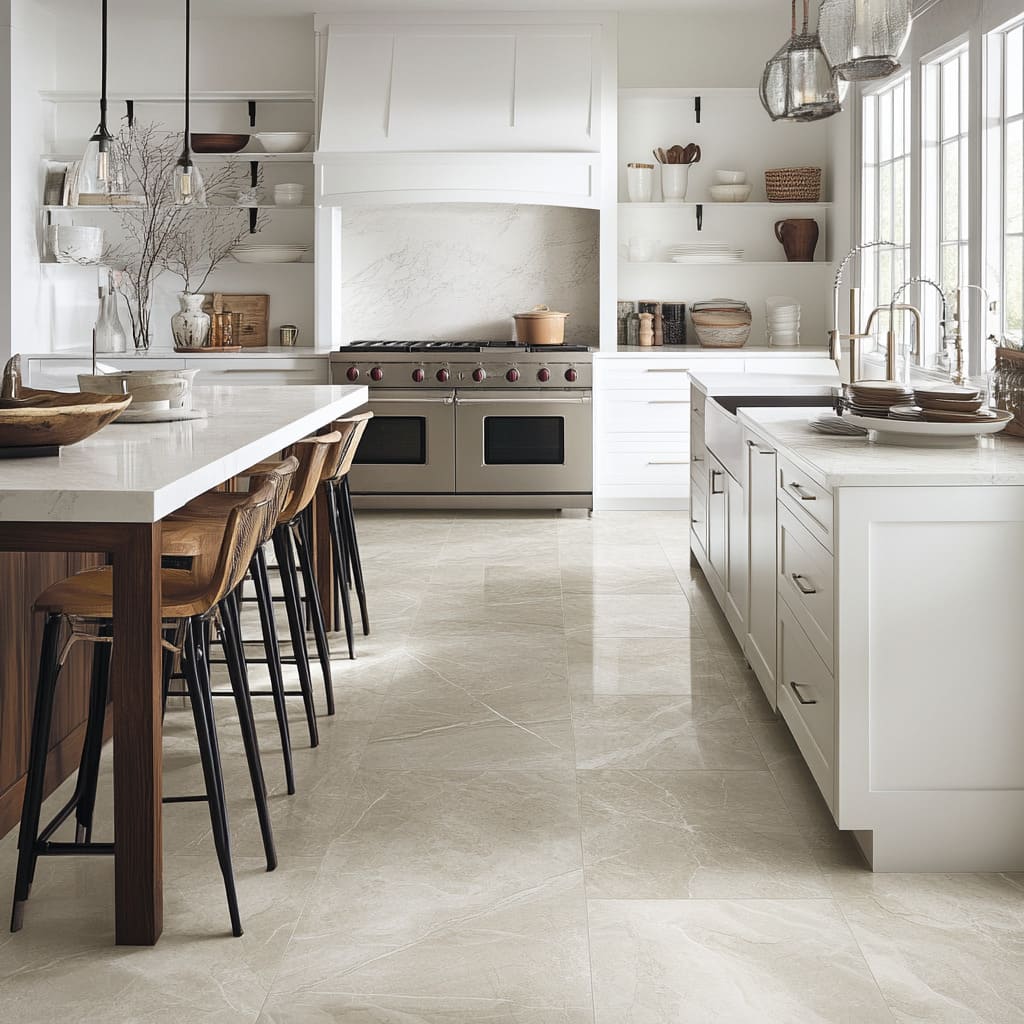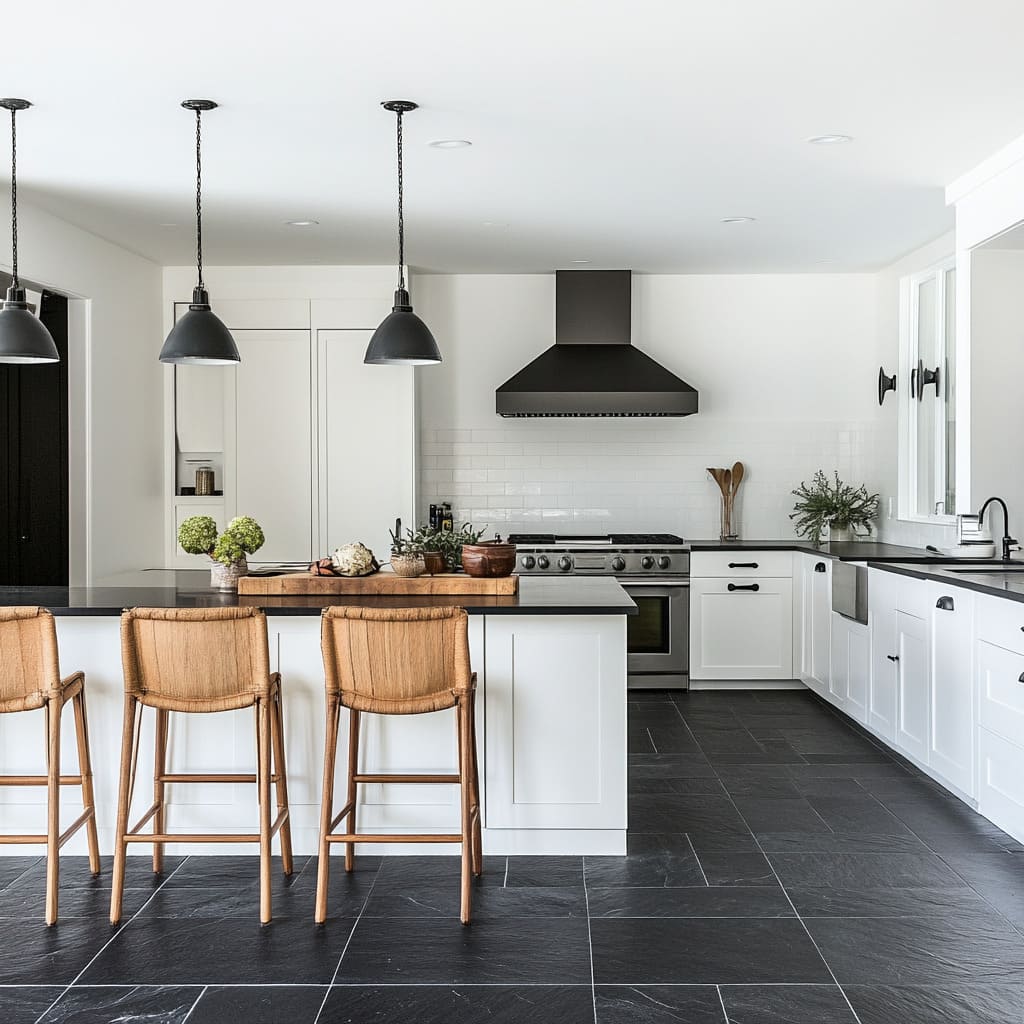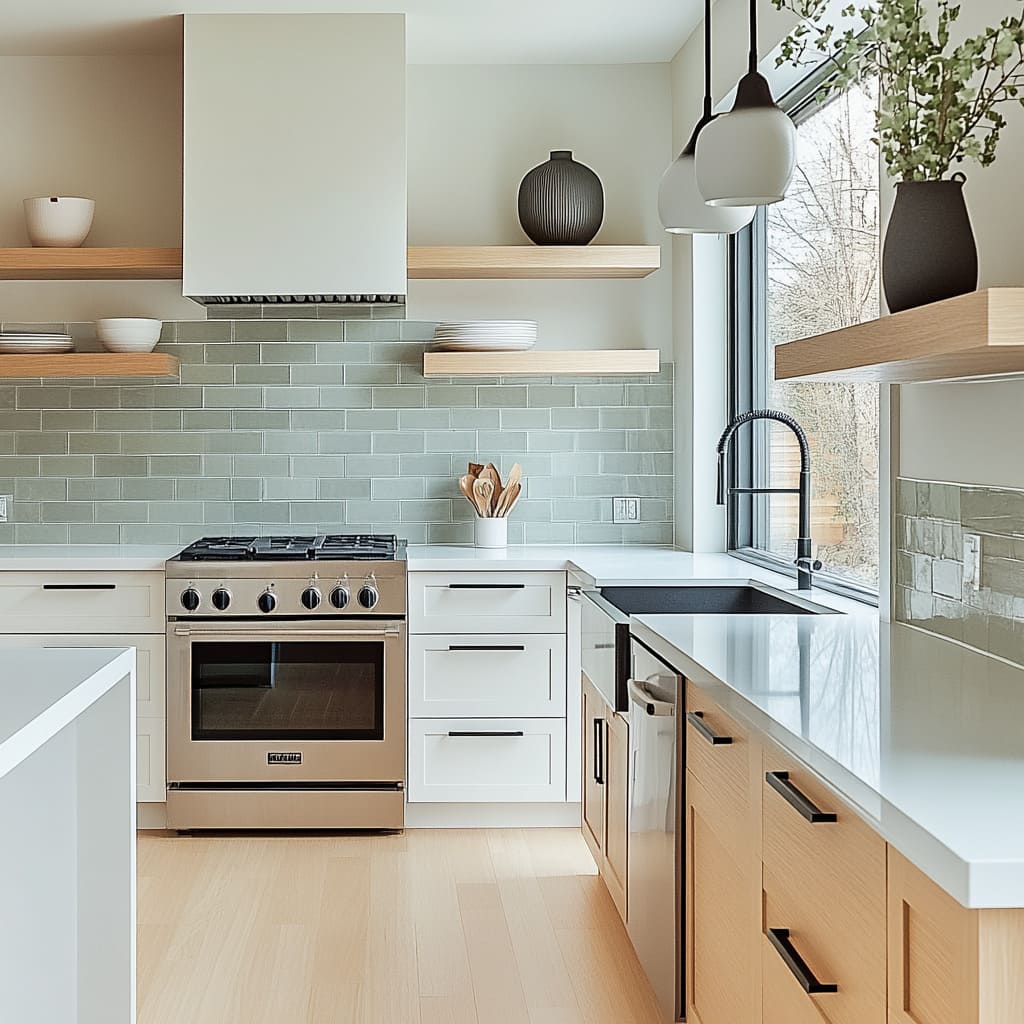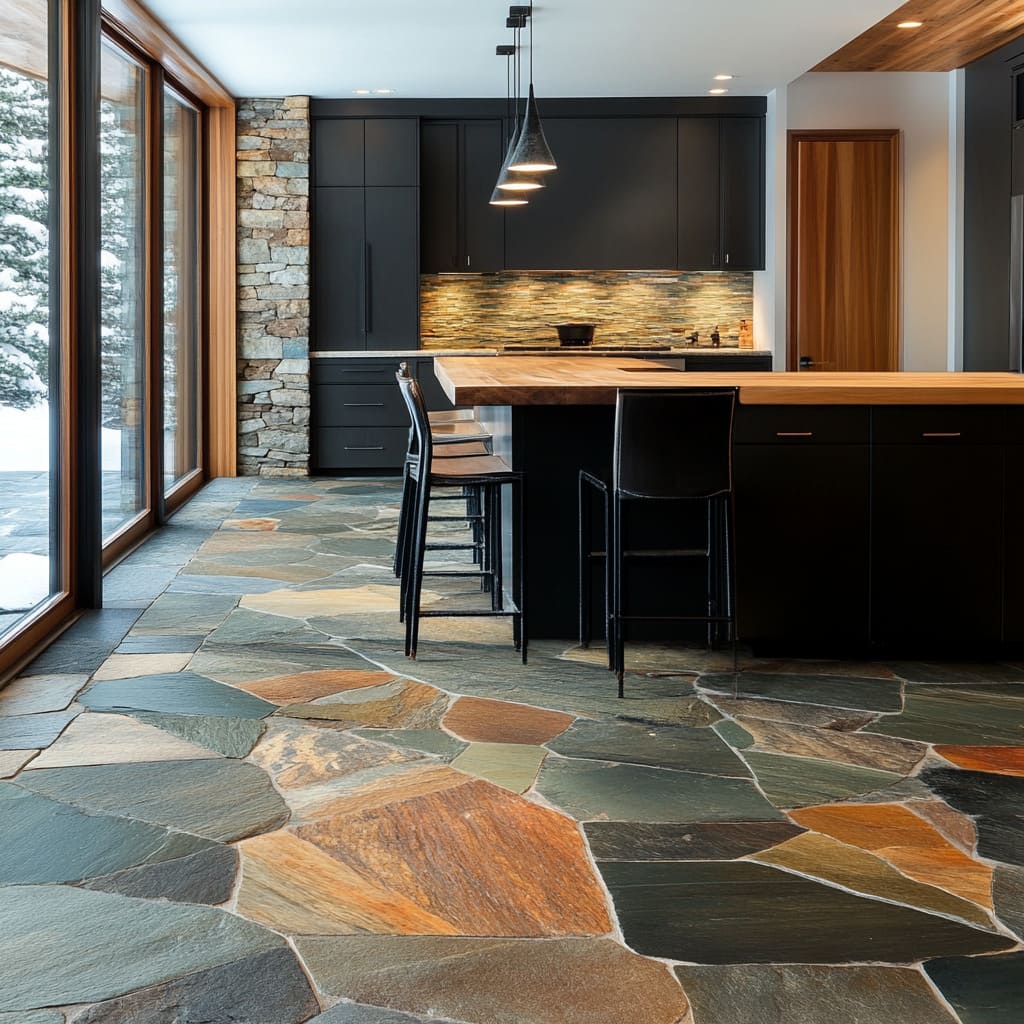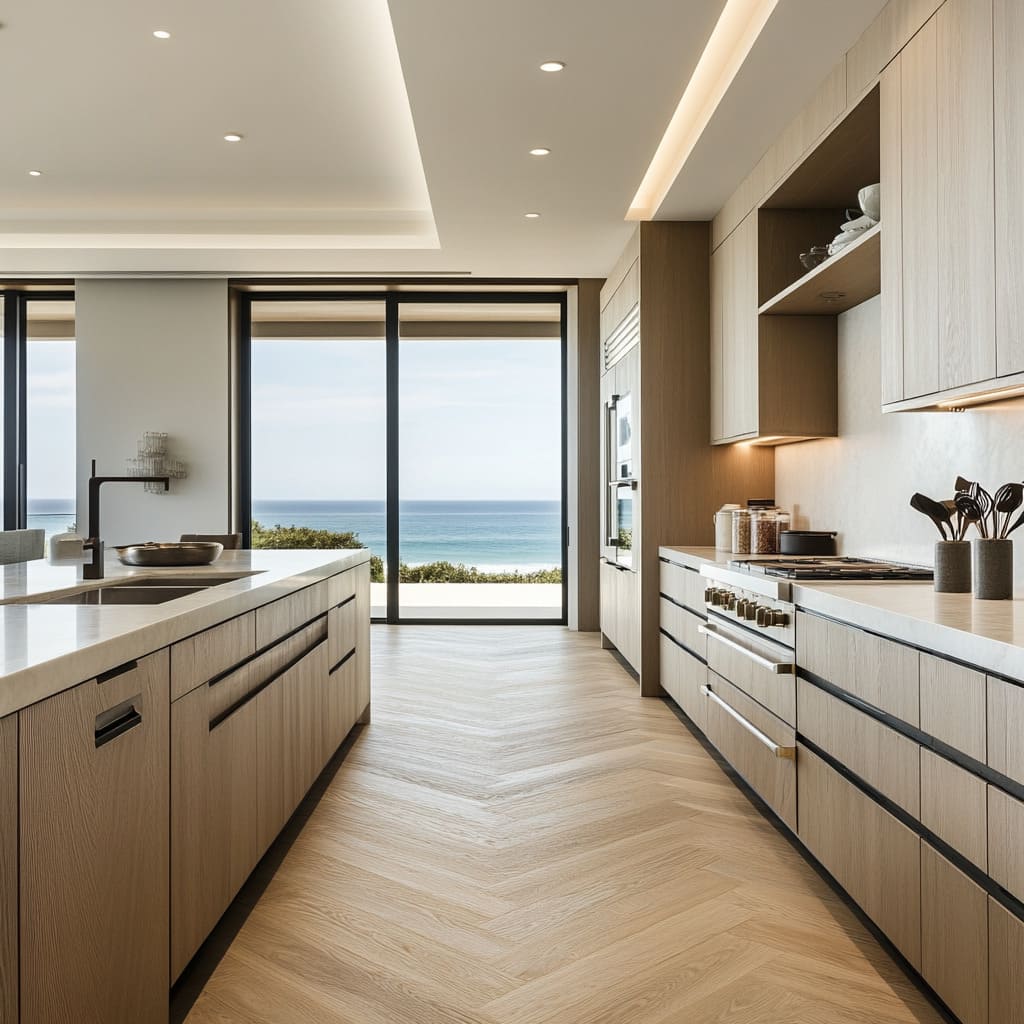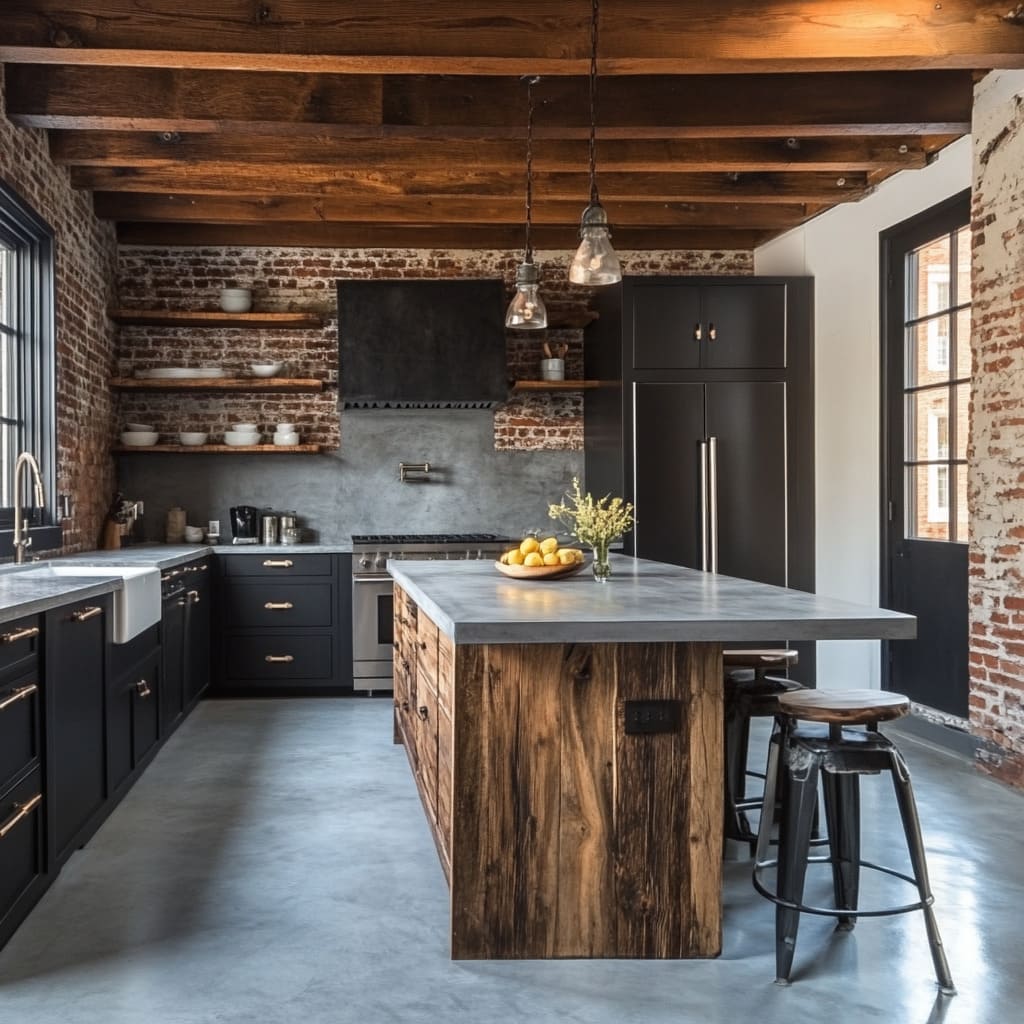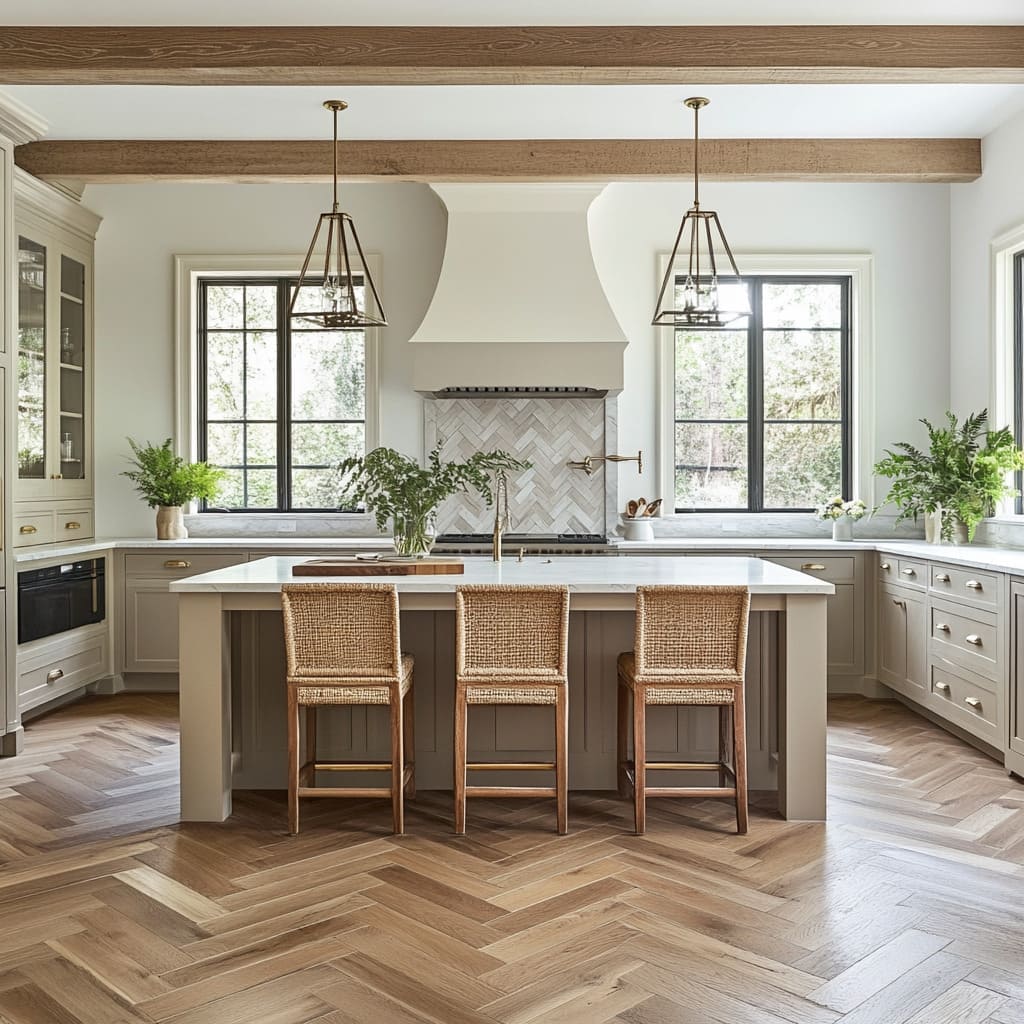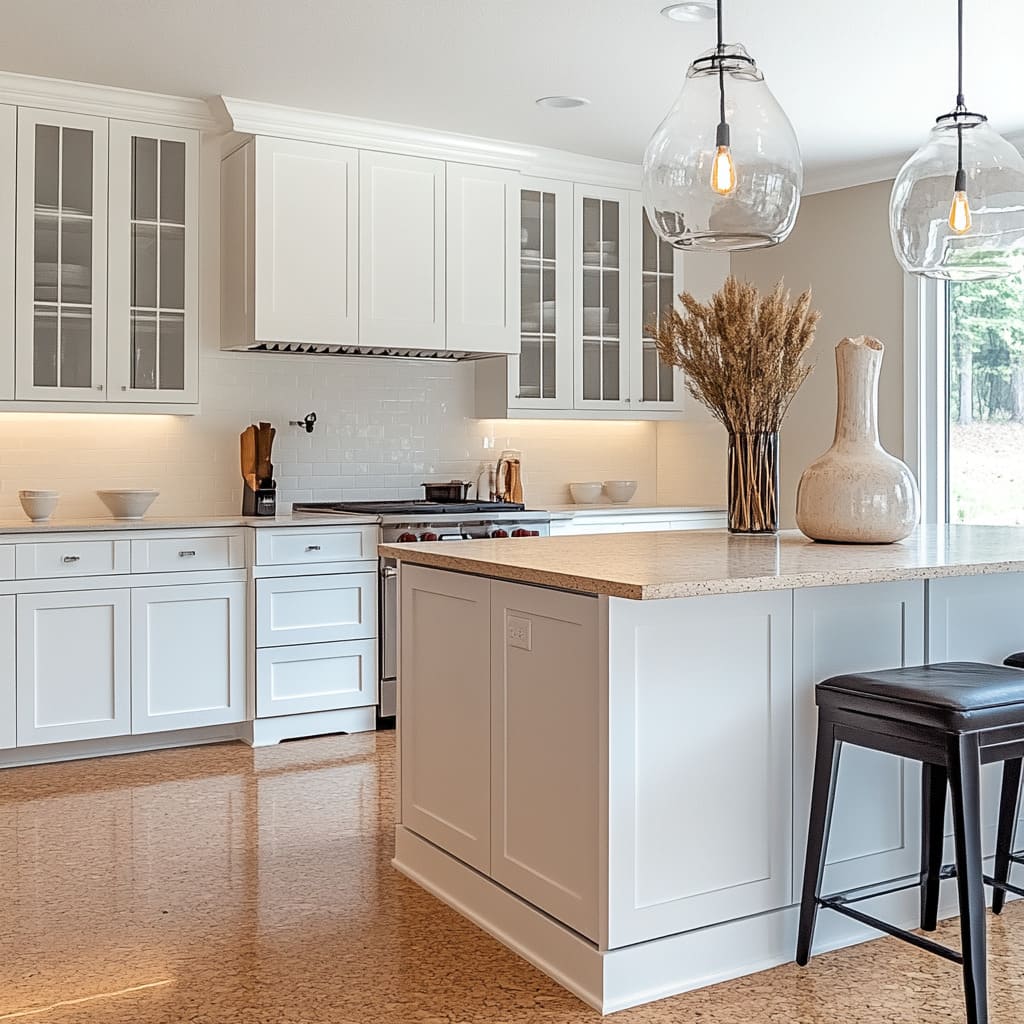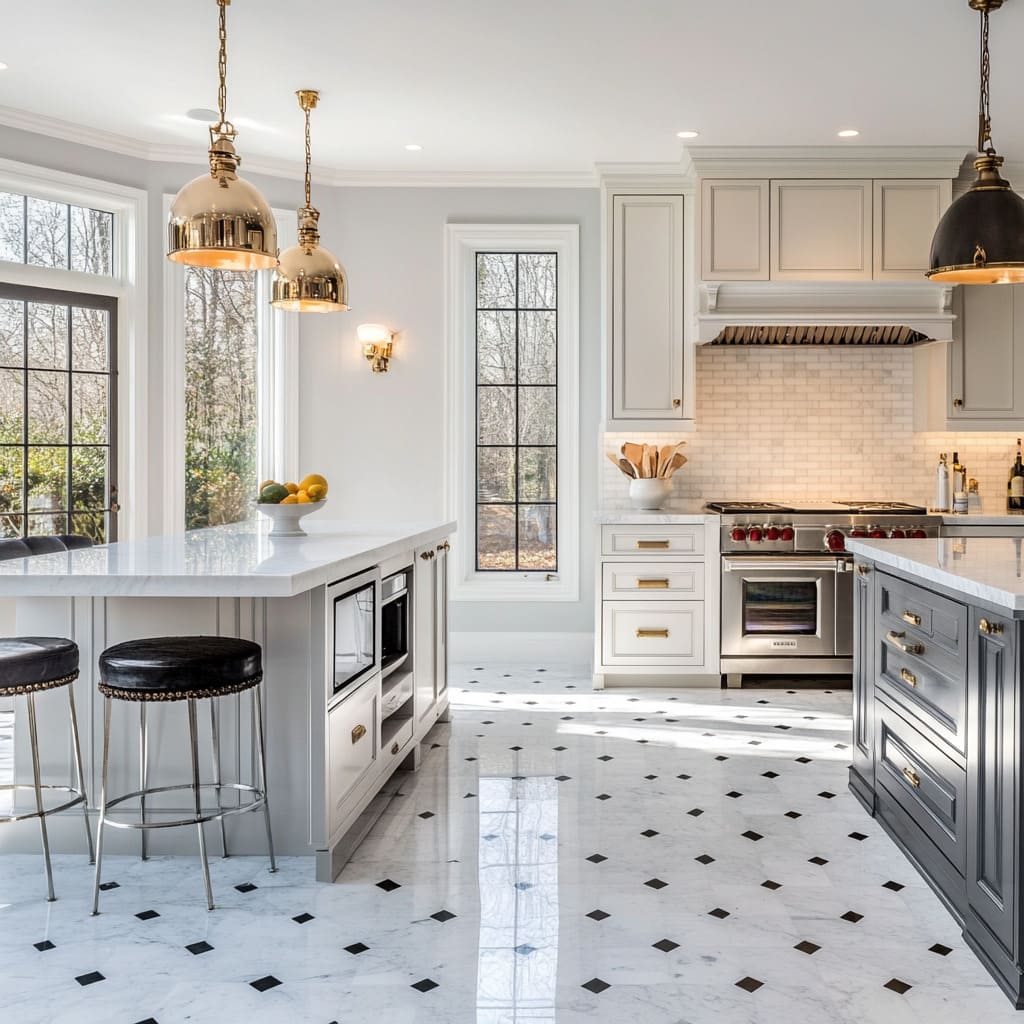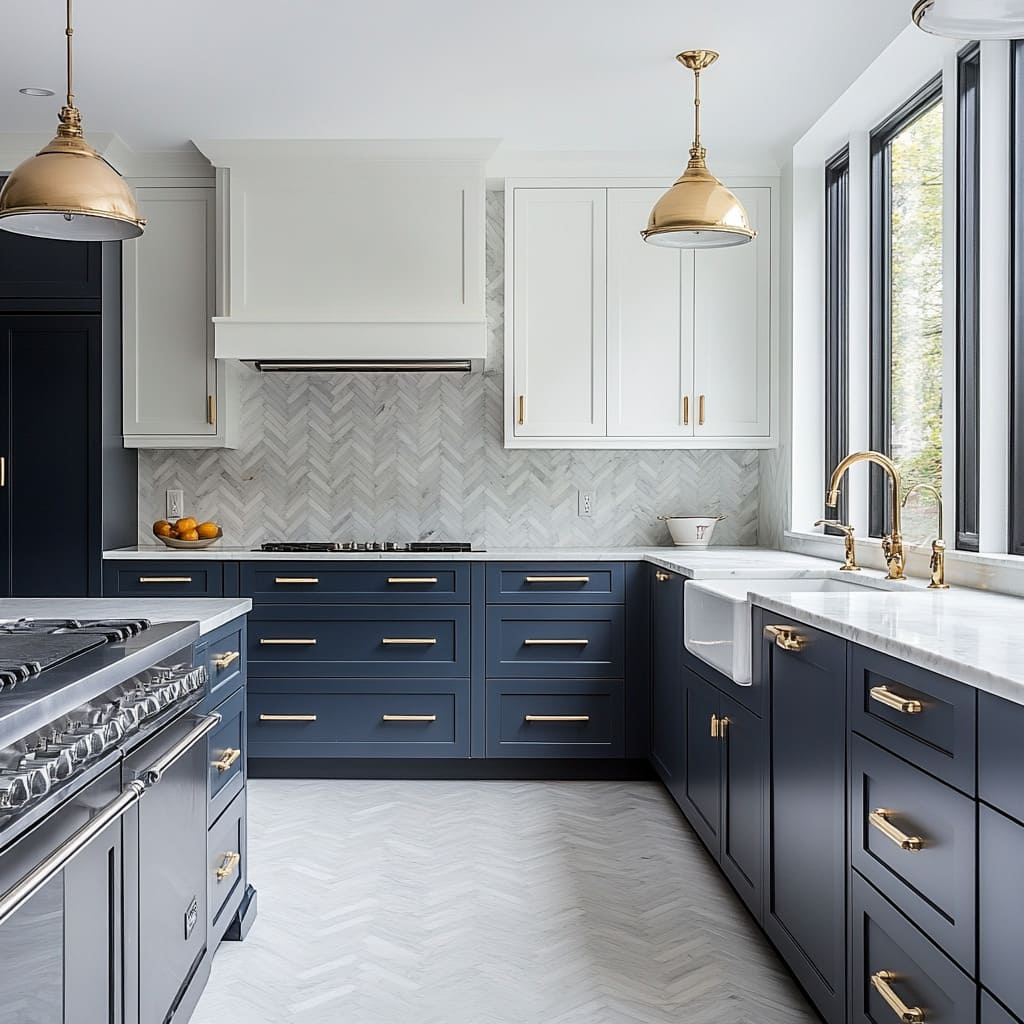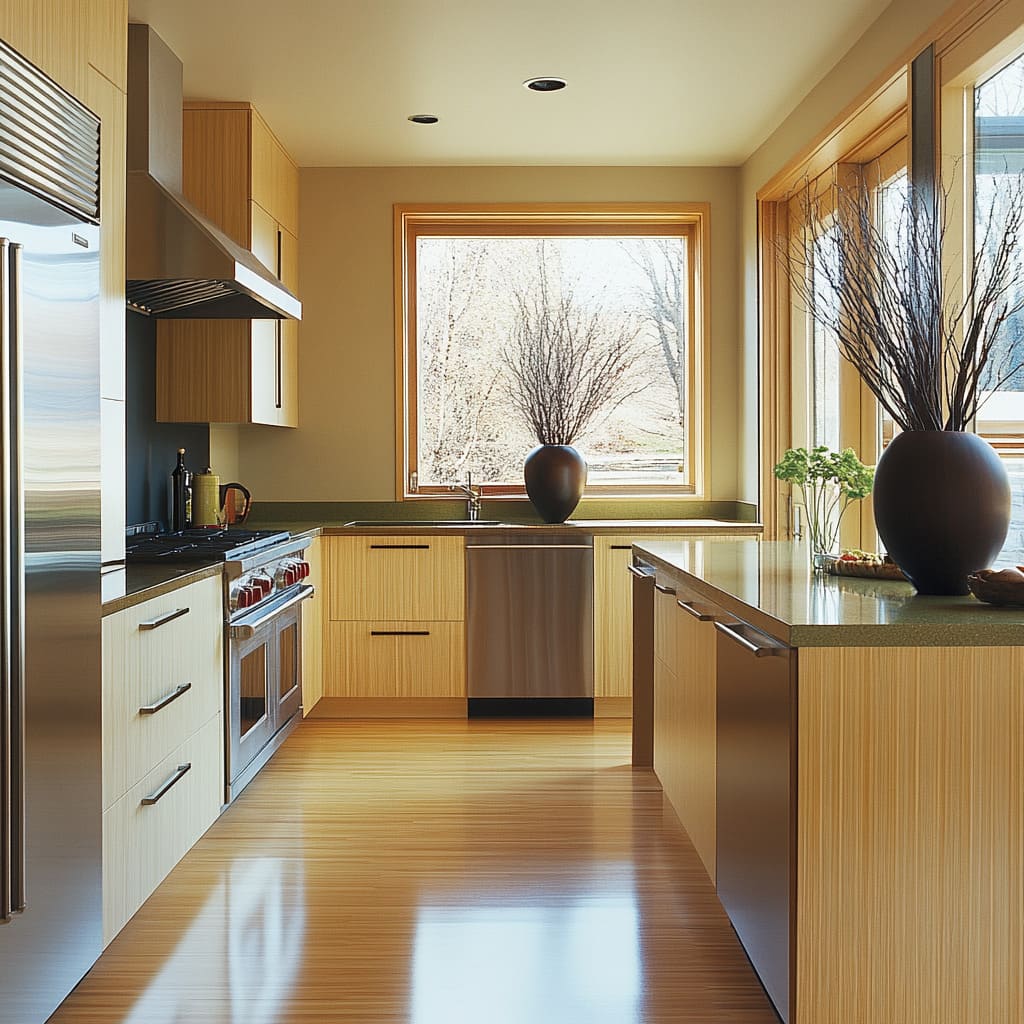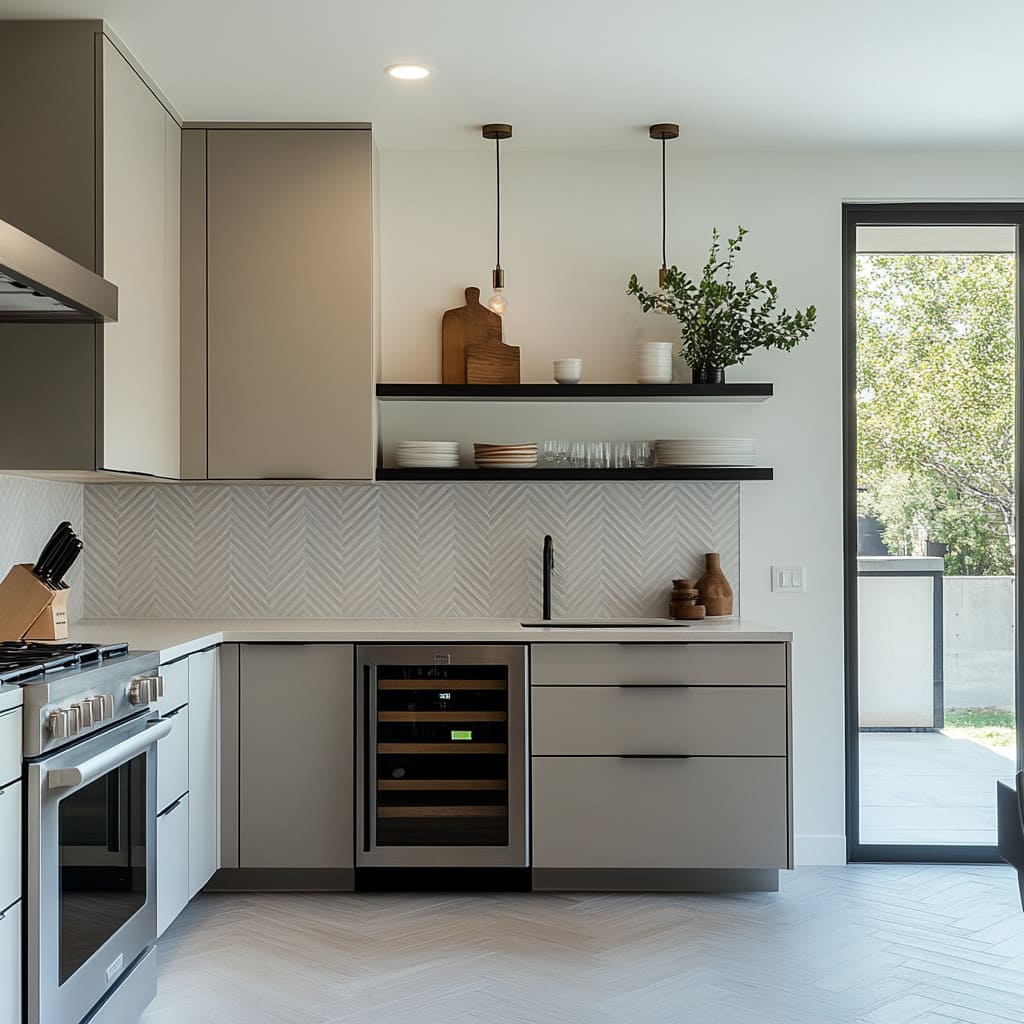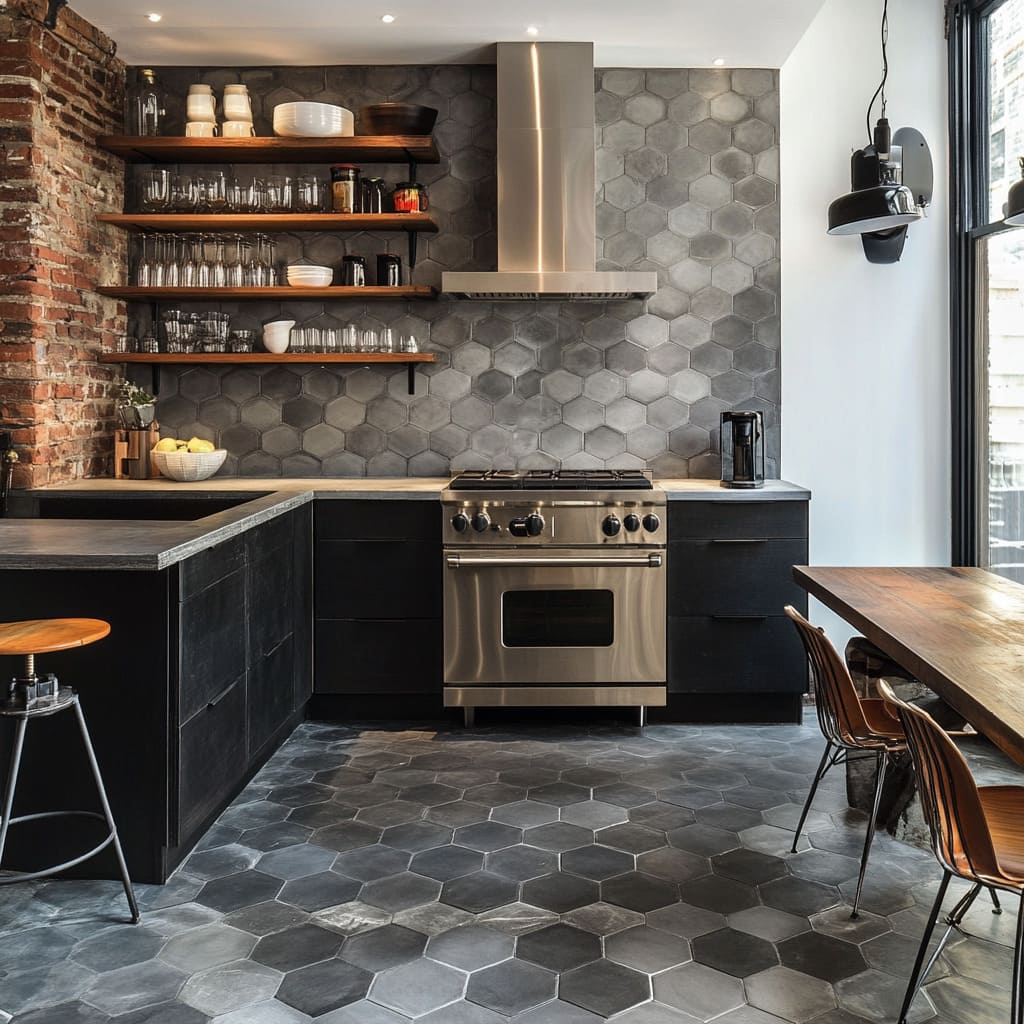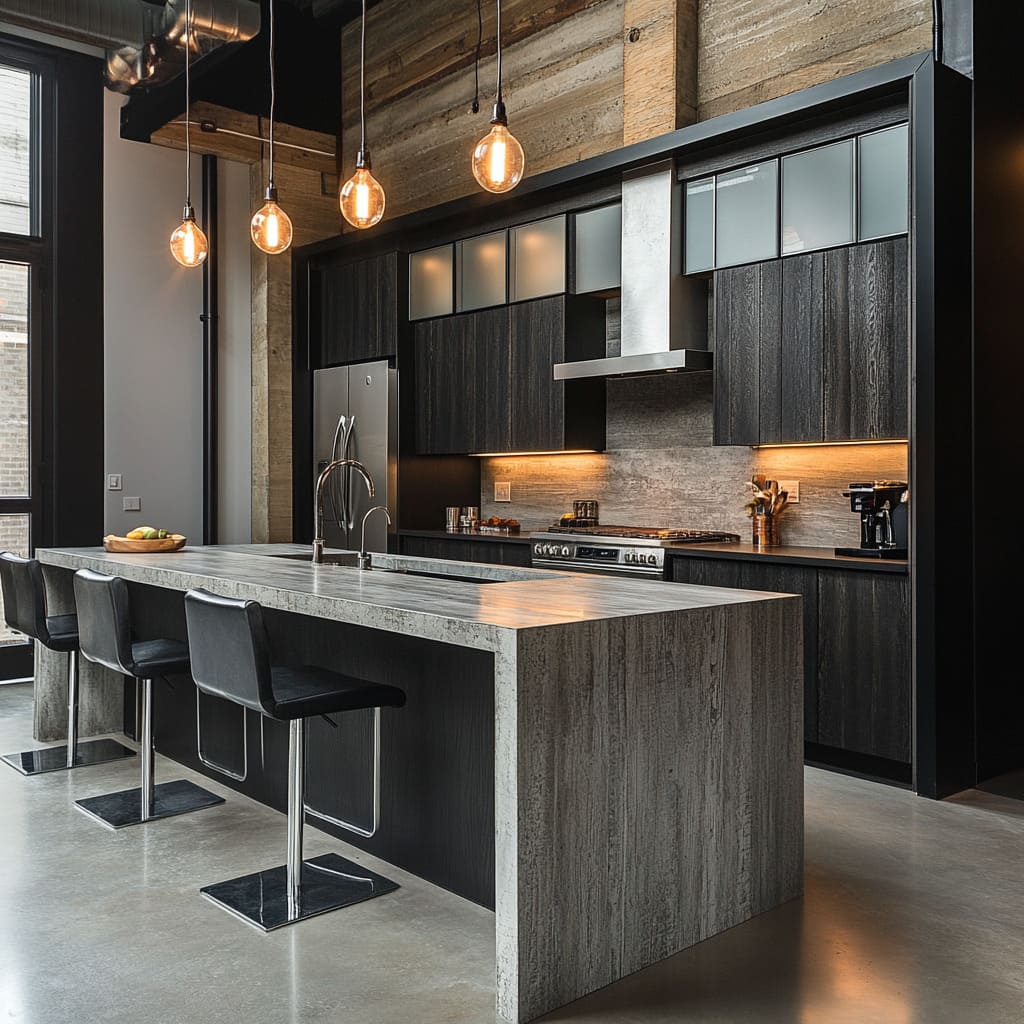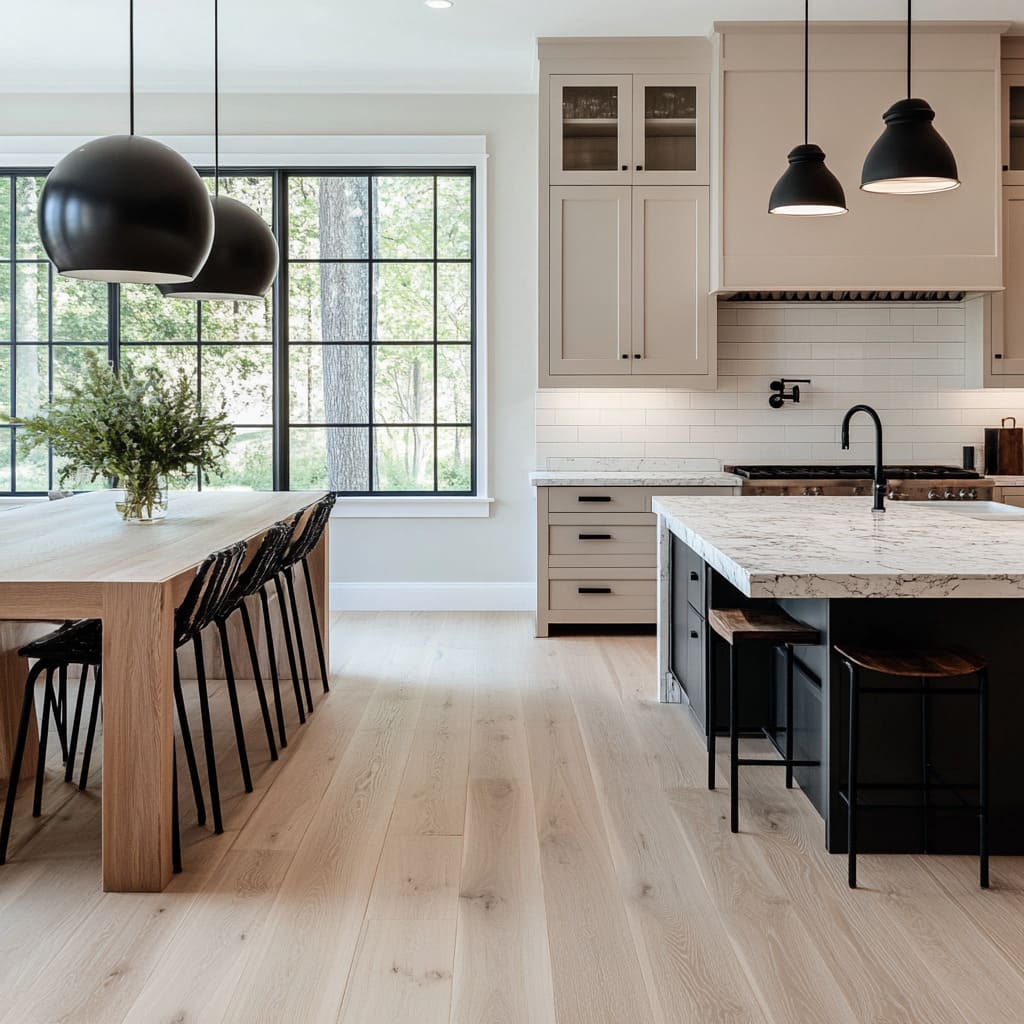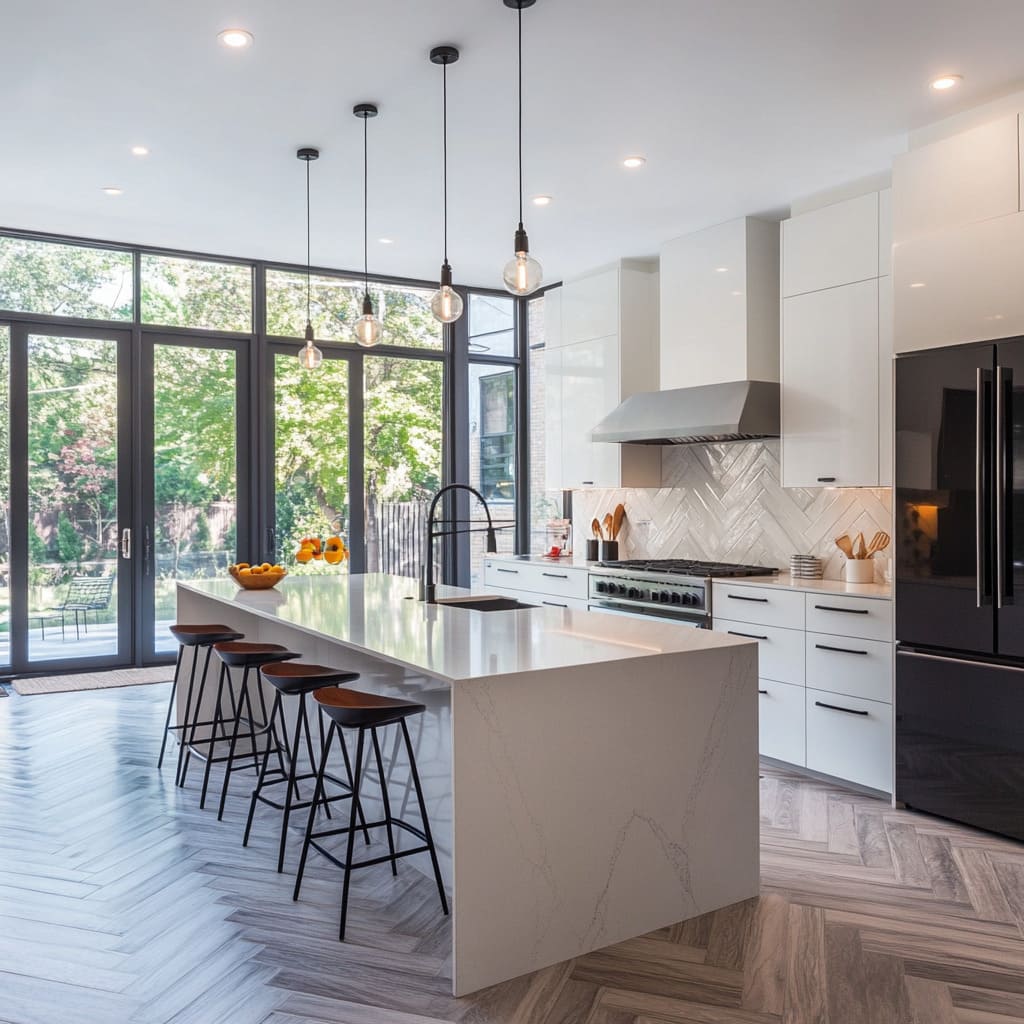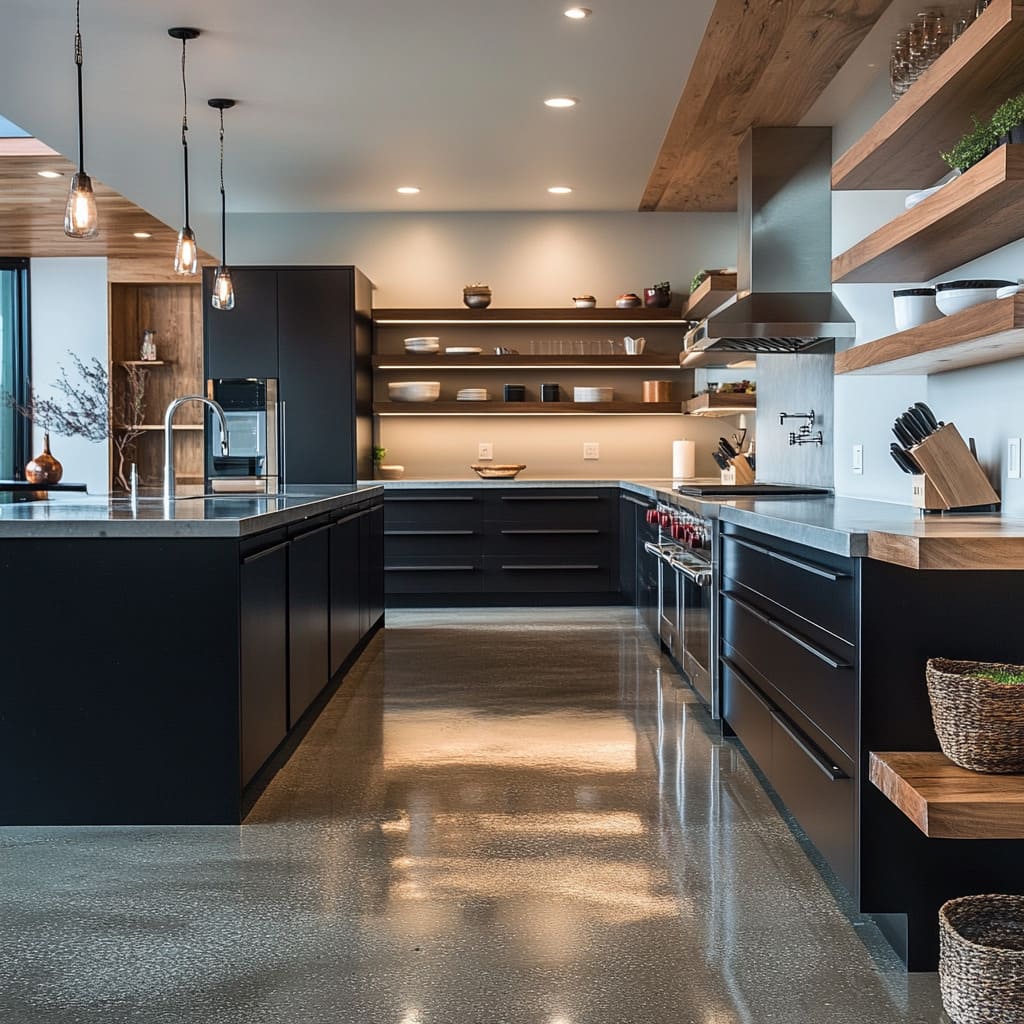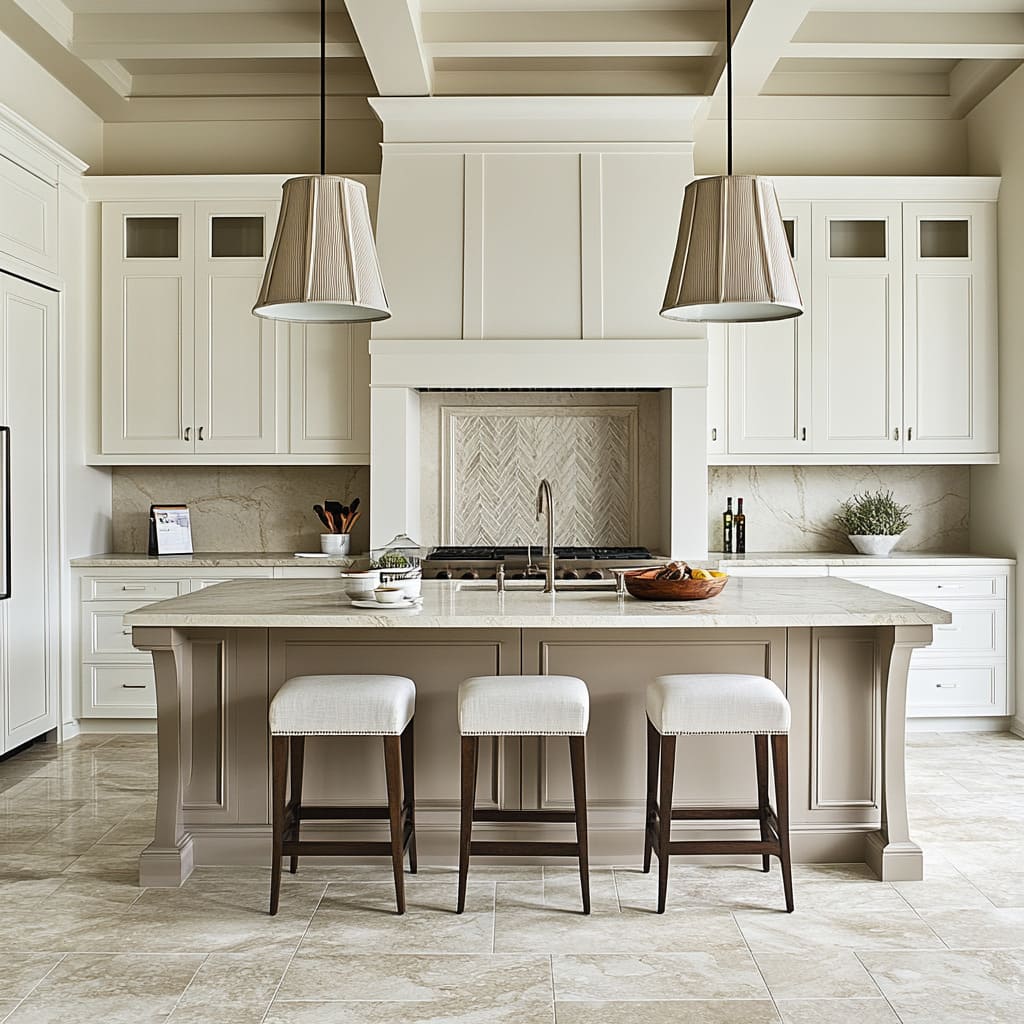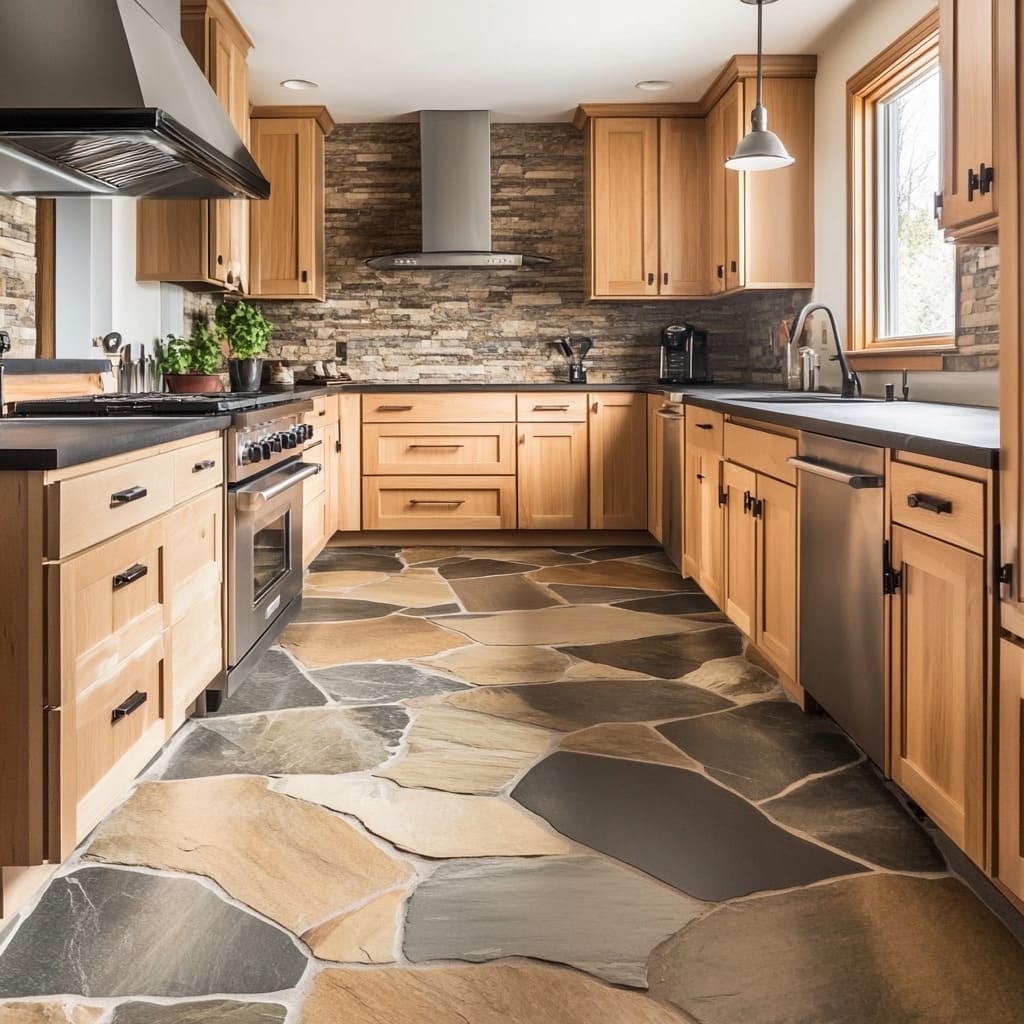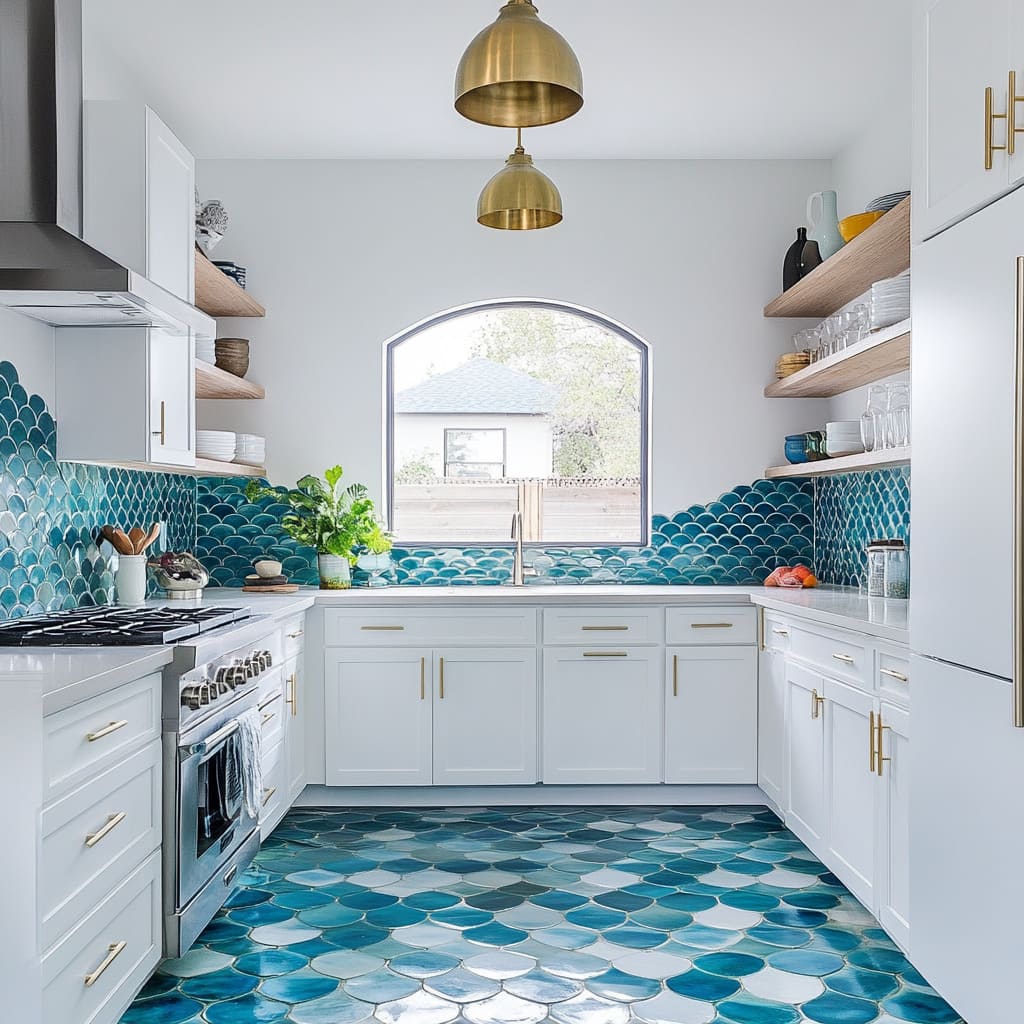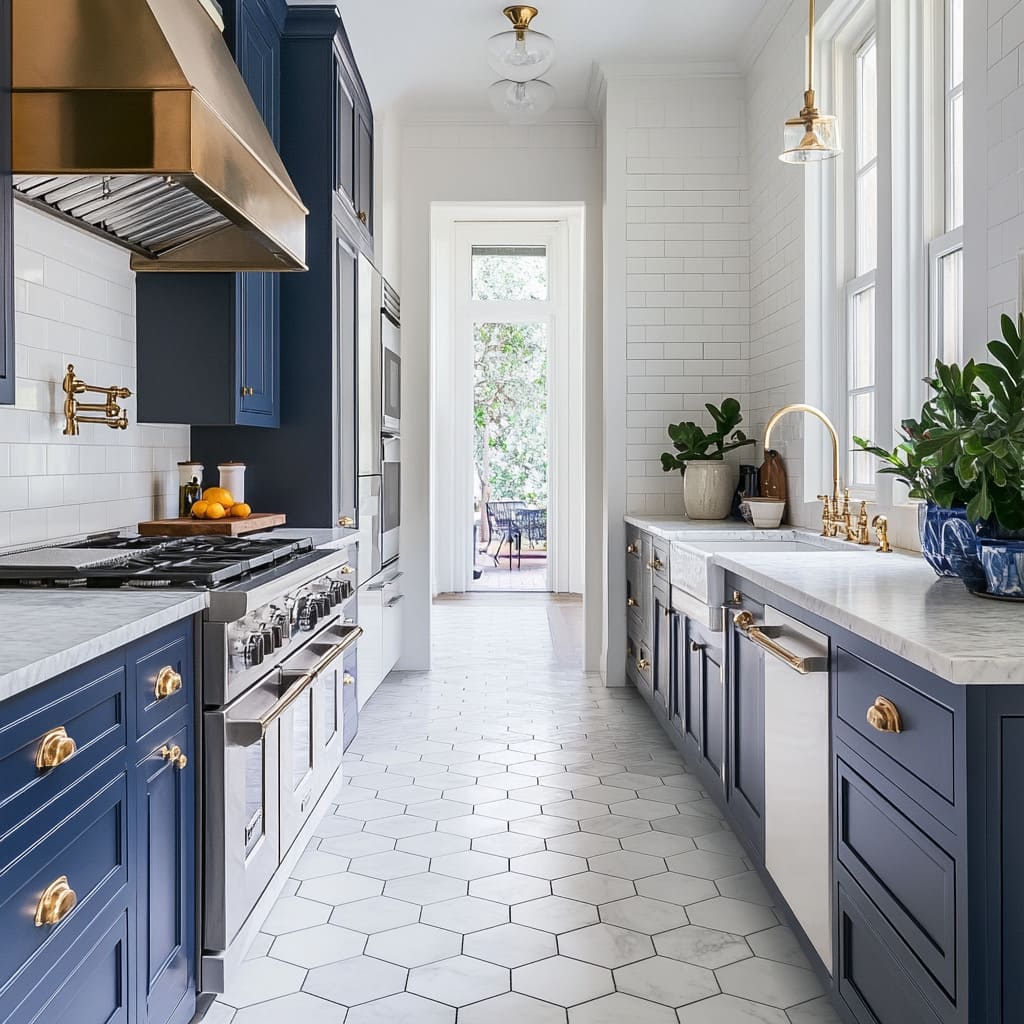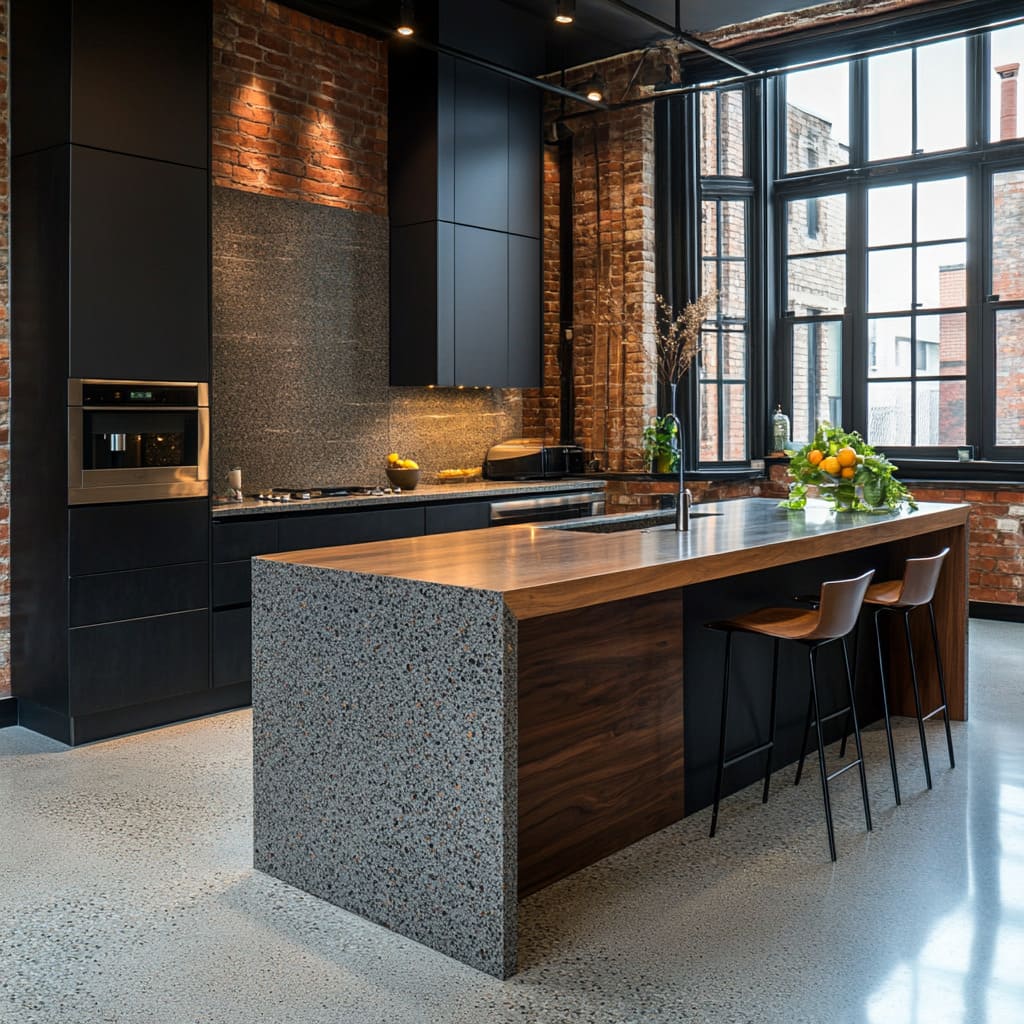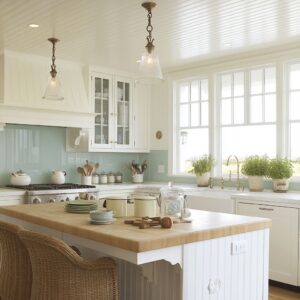When designing or renovating a kitchen, flooring often takes a backseat to cabinets, countertops, and appliances. But the truth is, the right flooring choice can redefine the heart of your home, merging style with functionality in a way that impacts every aspect of the space.
Beyond its visual role, your kitchen floor is the hardworking foundation that must handle heavy foot traffic, inevitable spills, and the wear and tear of daily life—all while contributing to the overall aesthetic of your design.
From modern open layouts to cozy traditional kitchens, flooring has the ability to tie together a space, enhancing its character and usability. For example, a rustic kitchen with natural wood tones benefits from the warmth of distressed hardwood, while a contemporary design may call for sleek concrete or polished porcelain.
The material, finish, and layout you choose can dramatically alter how the space feels and functions. Looking at pictures of kitchen floors from different styles and materials can inspire you to select an option that perfectly suits your kitchen’s needs and personality.
In addition to aesthetics, your choice of kitchen flooring must take practicality into account. For busy households, easy-to-clean and durable surfaces like porcelain or sealed concrete can be lifesavers.
On the other hand, those seeking comfort underfoot might gravitate toward cork or bamboo. These decisions shape not only the way your kitchen looks but also how it works for you on a daily basis.
Whether you’re drawn to bold patterns like herringbone or timeless options like marble, flooring has the power to anchor the kitchen’s design while introducing subtle texture and depth. By investing time in exploring various materials, finishes, and layouts, you ensure your kitchen floor complements the rest of your design choices seamlessly, creating a cohesive and functional space that feels like home.
How Flooring Influences Overall Kitchen Aesthetics
The choice of flooring plays a pivotal role in shaping the overall character and atmosphere of a kitchen. Beyond its functional purpose, the material, color, and pattern of the floor serve as a foundation for the entire design, tying together cabinetry, lighting, and decor.
By thoughtfully selecting a floor that complements the kitchen’s style, homeowners can achieve a cohesive and visually appealing space.
Material-Style Matching
Each flooring material tells its own story, blending functionality with aesthetics to suit specific kitchen styles.
Concrete and Industrial Style
Concrete, whether polished or matte, seamlessly fits into kitchens with industrial themes. Its subtle imperfections, such as hairline cracks or faint tonal variations, contribute to the raw charm often seen in loft-inspired spaces.
The muted gray tones of concrete complement exposed brick walls, steel fixtures, and reclaimed wood beams, creating a unified and intentional industrial aesthetic. The neutrality of concrete also allows bold accents to shine.
Marble or Marble-Look Porcelain for Classic and Transitional Styles
Marble is synonymous with luxury, offering timeless sophistication through its natural veining. When paired with Shaker-style or recessed-panel cabinetry in navy, white, or gray, marble adds a refined touch.
Marble-look porcelain tiles, a practical alternative, mimic this elegance while offering durability and easier maintenance. Kitchens inspired by traditional or transitional designs benefit from the subtle depth marble provides, creating a polished yet approachable space.
Wood Flooring for Warm and Inviting Kitchens
Wood tones bring an inherent warmth to any kitchen. Scandinavian-inspired spaces often feature lighter wood species such as oak or ash, amplifying the airy and minimalist vibe.
Rustic or farmhouse kitchens lean into darker or distressed finishes, evoking a sense of history and charm. Bamboo is another versatile option, blending eco-conscious design with a clean, modern look.
Stone (Slate or Flagstone) for Rustic-Modern Fusion
Authentic slate or slate-look tiles add earthy textures that bridge rustic and modern elements. Their rich tones pair beautifully with wood cabinetry and natural stone countertops, grounding the space while providing visual interest.
Porcelain Tiles for Versatility
Porcelain tiles are chameleons in the world of kitchen flooring, capable of mimicking nearly any material while delivering unmatched durability. Large-format tiles are excellent for achieving a sleek, grout-line-free aesthetic in contemporary kitchens.
Color Balance
The color of the flooring can make or break the overall harmony of a kitchen. Selecting the right shade ensures that the floor complements other design elements without overwhelming the space.
Light Floors for Brightness
Pale wood or light-toned stone floors work wonders in small or narrow kitchens, bouncing light around the room to create an open and airy feeling. These lighter shades pair well with white or pastel cabinetry, reinforcing a bright, welcoming atmosphere.
Medium Tones for Versatility
Flooring in taupe, soft gray, or light brown strikes a balance that suits almost any design style. These tones work particularly well with cabinets in green, navy, or black, as they create a backdrop that highlights the cabinetry without overpowering it.
Dark Floors for Contrast
Kitchens with dark-stained hardwood, charcoal stone, or black slate floors exude drama and sophistication. These floors create striking contrast when paired with white or light-colored cabinetry and counters.
To prevent the space from feeling too heavy, it’s essential to incorporate ample lighting.
Pattern Implications
Flooring patterns are not just decorative; they shape the way a space feels and functions.
- Herringbone, Chevron, and Basketweave: Patterns like herringbone and chevron bring dynamic movement to the floor, drawing the eye across the room and adding energy to the design.
- Hexagonal and Geometric Designs: Geometric tiles offer clean lines and bold visual interest. Hexagonal tiles, for instance, can define distinct areas within an open-concept layout.
- Mosaic and Smaller Patterns: Mosaic floors, with their intricate designs and smaller tiles, are ideal for creating a feature statement. A tile rug effect, where a mosaic is used in a specific section of the floor, can highlight areas like the island or sink, adding layers of interest.
By understanding the interplay between materials, colors, and patterns, homeowners can choose flooring that not only complements their kitchen but also enhances its functionality and visual appeal. Whether inspired by the clean lines of Scandinavian design, the raw appeal of industrial spaces, or the timeless elegance of classic kitchens, the right flooring serves as a vital element in creating a space that feels cohesive and inviting.
Correlations with Kitchen Layout and Functional Aspects
The relationship between flooring and kitchen layout extends beyond aesthetics. It’s about creating harmony between the structural design of the kitchen and the flooring’s practicality, durability, and visual impact.
Flooring has the power to emphasize a layout’s strengths or mitigate its challenges, making it a critical design element for both style and usability.
Layout Shapes
The shape of the kitchen layout significantly affects how flooring is perceived and how well it serves the functional aspects of the space. The right flooring choice can complement the layout while solving potential design challenges.
Galley Kitchens
Often narrow and linear, galley kitchens benefit from flooring that visually widens or elongates the space. Light-colored or reflective materials like polished marble or porcelain tiles bounce light, creating an open and airy feel.
Diagonal or lengthwise patterns can further enhance the perception of space, turning a compact galley kitchen into a visually spacious environment.
Open-Concept Designs
In kitchens that blend seamlessly with dining and living areas, continuous flooring plays a crucial role in creating unity. Materials like concrete or large-format porcelain tiles with minimal grout lines offer a smooth, cohesive look, particularly fitting for modern or industrial-inspired homes.
Continuous flooring eliminates transitions, enhancing the open and fluid atmosphere.
Island-Centric Layouts
Kitchen islands are often the centerpiece of larger layouts, and flooring can help highlight them as focal points. Patterned flooring, such as herringbone or mosaic designs, naturally draws attention to the island.
For a bold statement, dark flooring beneath a light-colored island creates striking contrast, while lighter tones unify the space harmoniously.
Traffic Flow and Durability
Kitchens experience some of the heaviest foot traffic in any home. The flooring must withstand daily wear and tear while maintaining its appearance and functionality over time.
- High-Traffic Resilience: Durability is key in areas with constant foot traffic, especially in households with kids or pets. Materials like porcelain tiles, concrete, slate, and bamboo are known for their ability to resist scratches, dents, and wear. Scratch-resistant laminate also offers a practical and stylish solution for busy homes.
- Maintaining Consistent Temperature: Flooring can influence the kitchen’s thermal comfort. Concrete floors, when paired with radiant heating, stabilize indoor temperatures, making them ideal for regions with cooler climates. Stone floors, on the other hand, remain naturally cool, offering a refreshing experience in warmer areas.
- Ergonomics and Comfort: For those spending long hours in the kitchen, comfort underfoot becomes essential. Cork and bamboo flooring provide a slight cushioning effect that reduces fatigue, while cork’s eco-friendly nature aligns with sustainable design principles.
Maintenance Requirements
Everyday practicality is as important as aesthetics when selecting flooring. Maintenance considerations ensure that flooring retains its appeal over the years.
- Stain Resistance and Cleaning: Kitchens are prone to spills, making stain resistance a key factor. Porcelain tiles, sealed concrete, and properly sealed marble are easy to clean, maintaining their pristine look even after heavy use.
- Natural Wood and Moisture: Hardwood flooring, while beautiful, requires careful sealing to protect against moisture. Engineered wood or wood-look porcelain tiles are safer alternatives in high-humidity areas, combining the warm appearance of wood with water resistance.
- Surface Texture and Slip Resistance: Safety is vital in kitchens, especially for families with children or pets. Matte finishes on stone, porcelain, or textured wood provide added grip, reducing the risk of slips and falls.
Choosing the right flooring involves aligning the material, color, and texture with the kitchen’s layout and functional needs. Whether it’s reflective tiles for galley kitchens, durable materials for high-traffic areas, or slip-resistant finishes for safety, thoughtful decisions enhance both usability and visual harmony.
By balancing creative ideas with practical considerations, homeowners can create a kitchen that is both functional and beautiful.
Color and Cabinet Synergy: Achieving Balance in Kitchen Design
The interaction between flooring and cabinetry forms the backbone of kitchen design. Choosing the right combination of tones, materials, and accents ensures not only a visually pleasing aesthetic but also a cohesive flow that brings the kitchen’s style to life.
Each pairing of floor and cabinet colors creates unique effects, setting the tone for the kitchen’s overall vibe.
Tone-on-Tone Approaches
Creating harmony between the floor and cabinets requires an understanding of how tones interact. Whether the goal is a light and airy ambiance, bold drama, or warm and cool contrasts, the right pairings can transform the kitchen’s personality.
Light Floor + Light Cabinets
This pairing creates an open and airy atmosphere, perfect for smaller kitchens or spaces with limited natural light. Blonde wood flooring or light-colored tiles, combined with white or cream cabinets, maximizes brightness.
To avoid a uniform look, mid- to dark-tone accents such as matte black handles, brass hardware, or a contrasting island color (like navy or forest green) add depth and definition.
Dark Floor + Dark Cabinets
For a dramatic and sophisticated aesthetic, dark-stained hardwood floors or charcoal-toned tiles pair beautifully with deep cabinetry hues like espresso or navy. To balance the richness, reflective surfaces such as glossy backsplashes, metallic hardware, and glass-front cabinets help bounce light around the room.
Strategic lighting, like under-cabinet LED strips, ensures the space remains inviting.
Warm Floor + Cool Cabinets
Bamboo, oak, or walnut flooring brings a sense of natural warmth to the kitchen. Pairing these floors with cabinets in cool tones like sage green or muted gray creates a balanced contrast, adding dimension to the design. This combination works especially well in transitional or Scandinavian-inspired kitchens, where simplicity is key.
Cool Floor + Warm Cabinets
Stone or concrete flooring in gray or slate tones pairs well with warm wood cabinets like oak or cherry. This mix offers a cozy yet modern vibe, ideal for rustic-modern or industrial kitchens.
Warm-toned cabinets soften the coolness of the flooring, creating a welcoming space. Subtle textures, such as a woven rug or wood cutting boards, reinforce the cozy aesthetic.
Accent Pieces and Hardware
The finishing touches in kitchen design often tie the whole look together, adding personality and layers of interest.
- Black or Dark Metal Hardware: Dark hardware creates a striking contrast against lighter cabinets, complementing darker flooring tones like charcoal slate or polished concrete. For instance, matte black handles on light gray cabinets establish a cohesive link to darker floors.
- Brass and Gold Tones: Warm metallics like brass and gold add sophistication, working beautifully with warm-toned floors or stone surfaces. Paired with cool-colored floors, these accents introduce a layer of richness that enhances the overall design. From faucet fixtures to light fittings, even small touches of gold can make a significant impact.
- Wooden Elements: Open shelving and exposed beams bridge the gap between flooring and cabinetry. For kitchens with wood or wood-look flooring, matching wooden shelves create continuity from the floor to the upper sections of the room. Exposed beams unify the design and add an organic, timeless touch.
Fostering Synergy for a Unified Design
Pairing floors and cabinets is about more than matching colors—it’s about creating a design that feels complete and balanced. Whether you’re drawn to bold contrasts or harmonious tones, the interplay of materials, colors, and finishes can impact the kitchen’s ambiance.
By experimenting with warm and cool contrasts, tone-on-tone strategies, and thoughtful accents, homeowners can craft kitchens that reflect their style while incorporating trending kitchen flooring ideas seamlessly. Remember, the choice of flooring doesn’t just anchor the space—it interacts dynamically with cabinetry, hardware, and decor to create a kitchen that feels both functional and inviting.
From dramatic dark combinations to bright and airy pairings, each decision contributes to a design that resonates with practicality and beauty.
Enhancing Kitchen Floors Through Thoughtful Choices
When crafting the perfect kitchen design, it’s often the specialized observations and subtle decisions that make the most significant impact. While choosing a floor material or layout may seem straightforward, understanding how to blend materials, leverage lighting, and adapt to local climates can transform the space into something truly dynamic and functional.
Mixing Multiple Materials
The interplay of different materials in a kitchen not only enhances aesthetics but also ensures balance and functionality. A thoughtful approach to material combinations can help create a space that feels cohesive yet layered.
Concrete Floors with Wooden Accents
A concrete floor brings an industrial edge, but without careful balancing, it can lean toward a cold or stark appearance. Integrating warm wooden elements, such as butcher block countertops or ceiling beams, softens the look.
The raw feel of concrete contrasts beautifully with the natural grain of wood, creating a striking yet inviting atmosphere.
Marble or Marble-Look Flooring with Metallic Pendants
The natural veining in marble or porcelain tiles that mimic marble elevates a kitchen’s sophistication. Paired with metallic pendant lights, this combination reflects and amplifies light, making the space feel larger and more open.
This synergy is particularly effective in kitchens with fewer windows, reducing reliance on artificial lighting.
Textured Tile with Smooth Surfaces
Textured flooring, such as slate or matte-finish porcelain tiles, contrasts effectively with glossy cabinetry or stainless steel appliances. For minimalist kitchens, textured floors add character and complexity, keeping the design dynamic without bold patterns or colors.
Light Direction and Floor Impact
The way light interacts with the floor can dramatically change a kitchen’s mood and appearance. Considering both natural and artificial light sources can highlight key features and enhance functionality.
Natural Light Angles
Kitchens with large windows or glass doors benefit from the way sunlight interacts with flooring materials. For example, stone or concrete floors with subtle veining come alive under natural light, with the rays emphasizing their unique patterns.
A matte or lightly reflective finish ensures these details shine without glare.
Artificial Lighting
In kitchens where natural light is limited, artificial lighting can highlight floor details. Recessed spotlights can draw attention to polished marble or textured slate, while pendant lights above an island enhance patterned flooring directly below.
This layered lighting approach ensures the floor becomes an integral design element.
Seasonal and Climatic Considerations
Climate plays a pivotal role in determining the most suitable flooring materials for a kitchen. From managing indoor temperatures to resisting moisture, the right flooring choice can enhance comfort and longevity.
Cool Climates
Materials like concrete and stone, known for their thermal mass, are ideal in cooler regions. Paired with radiant heating systems, these floors retain warmth, creating a cozy atmosphere.
Wood and cork are also excellent options, offering natural warmth underfoot and a slight cushioning effect for comfort.
Humid or Coastal Areas
Kitchens in humid or coastal regions benefit from materials resistant to moisture and warping, such as bamboo, porcelain, or sealed concrete. Coastal kitchens often feature bright or reflective surfaces, enhancing the airy feel of the space and mimicking the natural brightness of the surrounding environment.
Crafting the Perfect Floor for Every Detail
Choosing modern kitchen floors is about more than just aesthetics—it’s about understanding how each material and design choice interacts with its environment. By combining materials like concrete and wood, utilizing lighting to its full potential, and tailoring choices to specific climates, homeowners can create a space that’s both visually stunning and highly functional.
Whether you’re drawn to sleek marble with metallic accents or textured tiles with smooth cabinetry, these combinations ensure the kitchen floor becomes an integral design feature. The best kitchen floor design ideas incorporate not just beauty but also durability, comfort, and practicality, ensuring the space feels as good as it looks.
Practical Tips for Your Kitchen: A Grounded Approach to Flooring Choices
Choosing the perfect kitchen flooring requires more than just aesthetics—it’s about understanding how function, style, and practicality come together. From handling daily wear and tear to ensuring the floor enhances the overall design, making the right decision can transform your kitchen into a space that’s both beautiful and functional.
Here are some in-depth, actionable tips to guide you through the process.
Assess Foot Traffic and Durability
The kitchen is often the most-used area in the home, and the flooring needs to reflect that level of activity. High foot traffic, kids, pets, or frequent cooking all require surfaces that can handle wear and tear without sacrificing style.
- Porcelain Tile for Resilience: Porcelain tile remains a top contender for heavy-use kitchens due to its toughness and resistance to scratches, stains, and spills.
- Sealed Concrete for Industrial Appeal: Concrete floors, when properly sealed, are nearly indestructible and resistant to stains, making them ideal for families seeking a chic, industrial look.
- Slate for Textural Durability: Natural slate offers a timeless, textured appearance and hides imperfections like scuffs, making it perfect for active kitchens.
If your kitchen floor sees more traffic than usual, these materials ensure you don’t have to compromise between practicality and visual appeal.
Coordinate with Cabinetry and Counters
Flooring and cabinetry must work in harmony to create a balanced, cohesive design. Whether you want the floor or the cabinets to be the standout feature, it’s important to ensure one doesn’t overwhelm the other.
- Lively Patterns with Simple Cabinets: Bold, patterned floors—like herringbone wood or intricate mosaic tiles—pair best with muted cabinets to avoid competition.
- Neutral Floors with Statement Counters: Eye-catching counters, such as quartz with heavy veining or bold granite, shine when paired with subtle flooring choices like soft-toned wood or light concrete.
- Contrast for Depth: Dark floors with light cabinets, or vice versa, create a pleasing contrast that adds depth and visual interest to the kitchen.
Deciding which element will dominate the visual hierarchy ensures the overall design feels intentional and well-balanced.
Mind the Lighting
Lighting plays a pivotal role in how flooring looks and feels. The same material can appear vastly different under various lighting conditions, so it’s crucial to account for both natural and artificial light when making your decision.
- Daylight Considerations: Polished marble or glossy porcelain tiles reflect sunlight beautifully, making kitchens with large windows feel brighter and more open.
- Artificial Lighting Tests: Matte finishes, such as textured stone or distressed wood, reduce glare and create a warm, inviting ambiance under artificial light. Pendant lights and under-cabinet LEDs can also highlight unique floor patterns or textures.
Request flooring samples and observe them in your kitchen at different times of the day to prevent surprises once the flooring is installed.
Plan for Future Changes
Kitchen renovations often happen in stages, so it’s important to choose flooring that will adapt to future updates, such as expansions or style changes.
- Continuous Flooring for Open-Concept Layouts: Large-format porcelain tiles or natural wood planks create a seamless flow into adjoining areas.
- Neutral Tones for Flexibility: Taupe, gray, or soft brown tones complement a variety of styles, ensuring longevity as other elements evolve.
- Pattern Consistency: Ensure flooring patterns remain consistent across zones, like a breakfast nook or pantry, to avoid a disjointed look.
Planning with flexibility in mind guarantees your flooring will remain timeless even as the kitchen evolves.
Match Maintenance to Your Lifestyle
Every flooring type has its own maintenance requirements, so it’s essential to choose one that aligns with your lifestyle and cleaning habits.
- Low-Maintenance Options: Porcelain tiles and sealed concrete are easy to clean and ideal for busy homes.
- Natural Stone Considerations: Stunning but higher-maintenance, stone floors like marble require periodic sealing to maintain their appearance.
- Wood and Laminate: Hardwood floors bring warmth but may show scratches over time. Engineered wood or laminate offers a low-maintenance alternative.
- Textured Tiles: These add character but can hold dirt in grout lines, requiring extra cleaning attention.
Choosing flooring that matches your lifestyle ensures your kitchen remains functional and stress-free, even during busy weeks.
Find Your Perfect Flooring
When it comes to kitchen floor inspiration, the best choices balance style, function, and practicality. Whether you prioritize durability for a busy household, seamless coordination with cabinetry, or future-proofing your design, every decision contributes to a kitchen that feels as good as it looks.
By carefully considering factors like traffic, lighting, and maintenance, you’ll create a space where the flooring doesn’t just support your kitchen—it enhances its charm and functionality. From timeless stone to modern concrete or warm wood tones, the possibilities are endless, allowing you to craft a space that truly reflects your style and needs.
Conclusion: The Impact of Kitchen Flooring on Style and Functionality
When it comes to kitchen design, flooring is far more than just a functional element—it’s the foundation that ties the entire space together. Choosing the right flooring can elevate the kitchen’s aesthetic while providing a durable, practical surface for everyday activities.
A well-thought-out modern kitchen floor idea ensures that your design vision and lifestyle are seamlessly aligned.
Uniting Style and Functionality
Flooring plays a vital role in defining the kitchen’s character. Whether your kitchen leans toward sleek modernity, timeless elegance, or rustic warmth, the floor sets the tone.
For instance, polished concrete introduces a contemporary industrial vibe, while hardwood planks lend an inviting charm ideal for farmhouse-inspired spaces. The floor anchors the room, creating harmony between the cabinetry, counters, and other design elements.
For kitchens with bold cabinetry or countertops, a neutral or understated floor provides balance, letting other features take the spotlight. Conversely, unique flooring patterns, such as herringbone or mosaic tiles, can act as a statement feature in kitchens with more subdued cabinetry.
Design Longevity and Practicality
A kitchen floor must withstand heavy traffic, spills, and wear while maintaining its appeal over time. Durable options like porcelain tile, sealed concrete, or engineered wood combine style and resilience.
The choice of material also impacts maintenance requirements—for example, marble floors require periodic sealing, while laminate or textured porcelain tiles are easier to clean.
Functionality doesn’t have to mean sacrificing style. Flooring that suits your day-to-day needs—such as slip resistance, ease of cleaning, or temperature regulation—ensures a kitchen that’s practical and beautiful.
A Cohesive Look That Lasts
The synergy between flooring and other design elements is what makes a kitchen feel cohesive. Coordinating tones and textures between the floor, cabinetry, and countertops creates visual flow.
For instance, light-toned floors brighten small kitchens, while dark flooring grounds large, open spaces with a sense of depth. These choices ensure the flooring works in harmony with the rest of the kitchen, rather than competing for attention.
Beyond aesthetics, the right kitchen floor can even influence how the space feels. Continuous flooring across open-plan areas creates a unified look, while textured or patterned surfaces can delineate zones for cooking, dining, or entertaining.
Enduring Appeal for Every Design Style
Whether your inspiration leans toward minimalist Scandinavian kitchens, coastal charm, or urban loft styles, flooring offers endless opportunities to customize your space. From sleek modern floor ideas to rustic designs featuring rich textures and natural tones, there’s a solution for every preference.
The key is to align your flooring choice with your kitchen’s overarching theme and practical needs.
By carefully considering factors like durability, maintenance, and how the flooring complements the overall design, you can ensure your kitchen floor remains both functional and visually impactful for years to come. A thoughtful approach to flooring is the foundation of a kitchen that’s not only beautiful but also built to endure daily life with ease.
